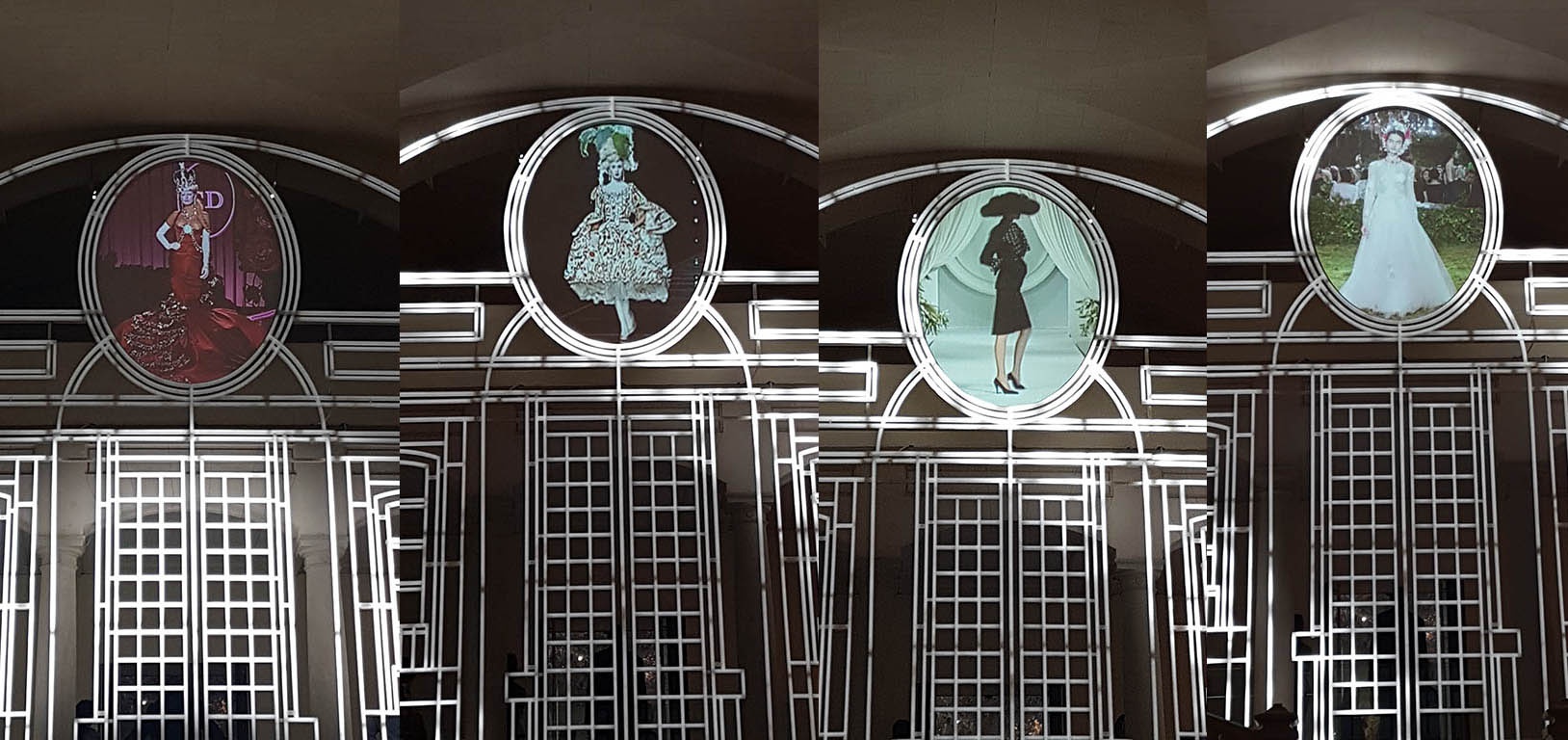Christian Dior Couture du Reve Sept' 2017
A celebration of 70 years of Dior style at the Musee des Arts Decoratifs
In the 70th anniversey year of the House of Dior, this celebration of the work of Christian Dior himself and his foundation of the House followed by the work of his successors to the present day, is probably the most internationaly celebrated fashion exhibition of the year.
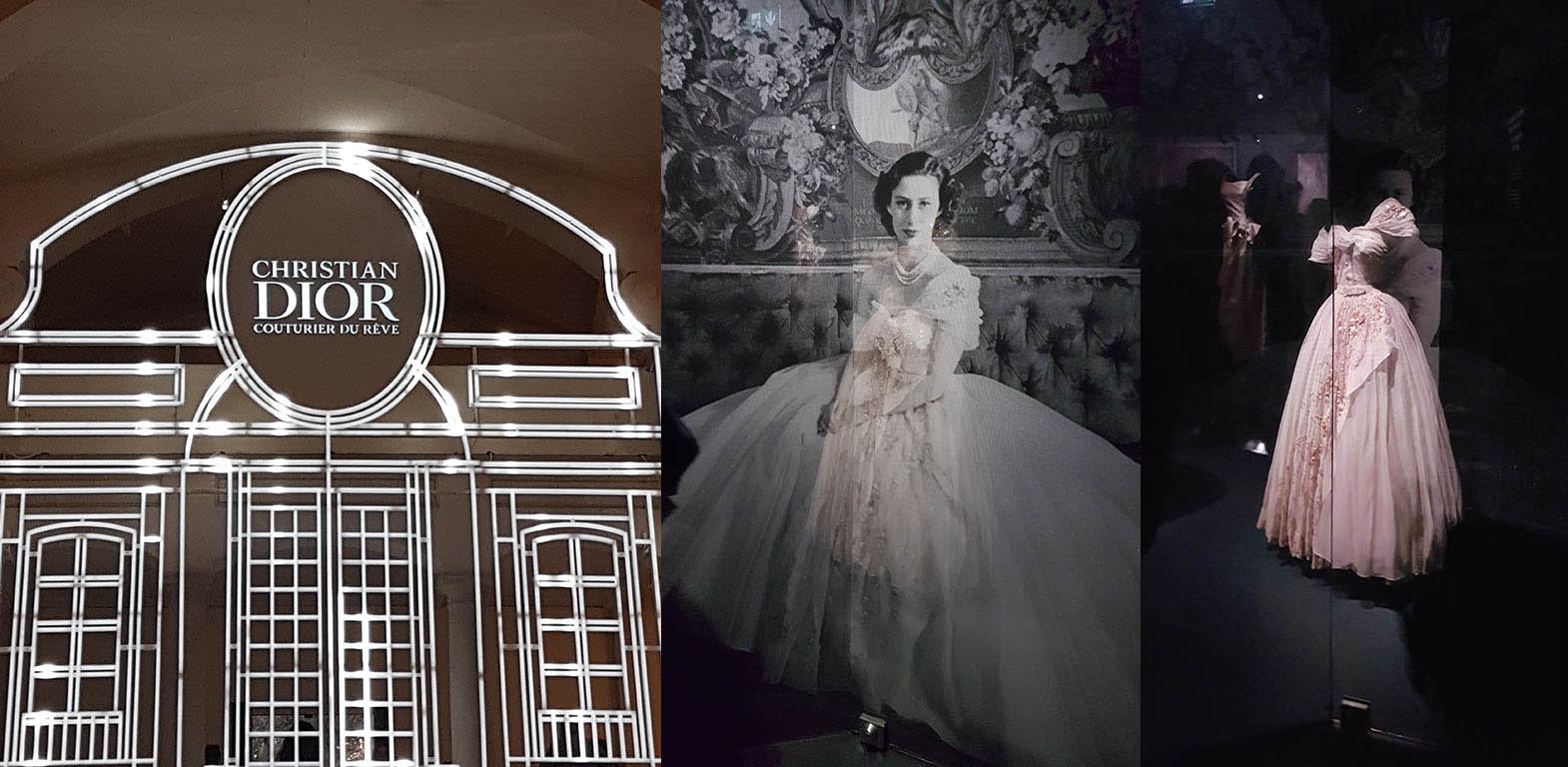
It rightly deserves to be and for large parts of the French public it not simply the interest of wealthy women but a key part of their national identity in terms of a craft that they excel at before the eyes of the world. This was clear during my visit to thronged galleries alongside the fashion faithful and many very interested French from all walks of life. Dior also has at it's heart a strong influence within it's origins in Britain that is not at first obvious, much like it's rival and counterpart, the House of Chanel. Christian Dior's mother and father were anglophile and the family home included household staff with the British origins. The family garden at their coastal home at Granville in Normandy at the turn of the 19th into 20th centuries, looking out across the English Channel, was heavily influenced by the English Country Garden. Dior himself also travelled widely in the UK in his younger years before the 2nd World War and saw England, Wales and Scotland. Notes of style and traditional mores of dress at the dawn the twentieth century slipped easily into his consciousness and would have a great influence, I feel, on the output of his later career.
Entering the exhibition a large cabinet displays, alternately in open view then opaque screen with filmed stills, dresses worn by the late Princess Margaret. She with Diana Princess of Wales were the two most well known patrons of Dior in the 20th century although fashion itself played a walk-on part of their lives alongside their other commitments. Princess Margaret's patronage of Dior beyond the life-time of the founder into the era of Mark Bohan was one of her longest relationships with a fashion House and certainly the longest of one that was not British. Dior understood how to create looks that met the needs of a contemporary Princess that retained the poise and demeanor of royal dress, something subtly different from the glamour of Hollywood and Cannes.
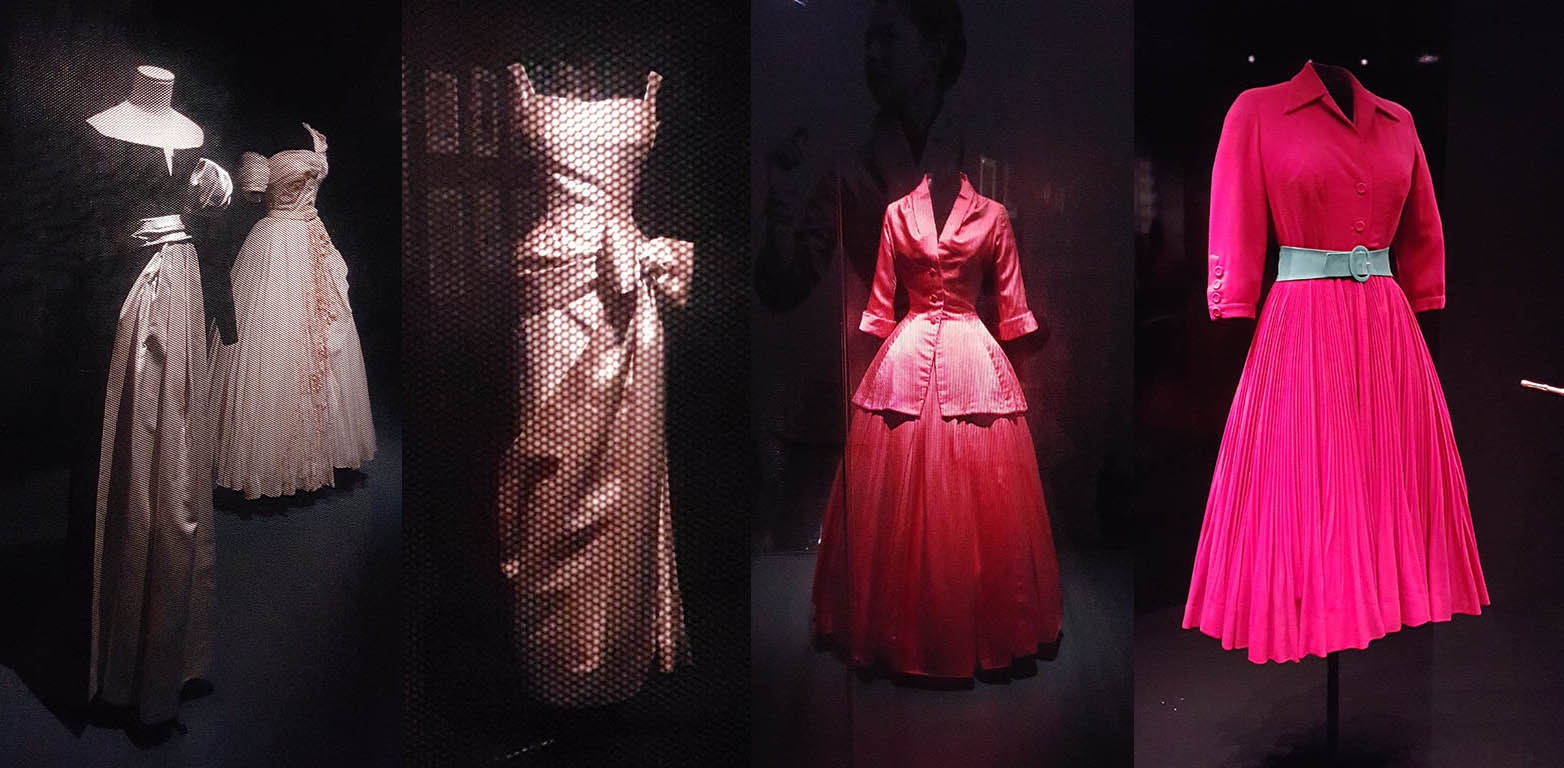
Revealed in tantalising glimpses, the dresses above are pure Haute Couture glamour. The white-ice pink full skirted dress furthest above was interchangeable with the image of it's wearer Princess Margaret. It still today could serve as a template for the perfect look of a fairytale glamour ball gown a defining fashion moment. Above to the left where the dress is shown from another angle another style that Dior mattered, the long line gown with an outer-layer faintly echoing the make morning suit coat, harmonises an icey Rose with Black in an elegant contrast. Christian Dior channel the nature and form of simplistic style and perfected it. He knew in a century where women's lives were changing they needed garments with the subtly and elegance of the past combined with ease of movement for the wearer. He was a student of design formerly training in architecture but he was also a clever businessman from a family of successful entrepreneurs and his thoughts turned naturally to what could sell and build the brand of Dior as we might say today. A floor length dress in Rose-Pink tied with a ribboned sash at the waist is a perfectly executed study in 20th century Haute Couture style. A Magenta silk coat sitting perfectly over a long gown creates a perfect formal wear ensemble that could be worn for a variety of occassions. The Magenta day dress to the right with it's Grey-Blue belt is another strong colour statement that could be worn with or without a coat across many seasons.
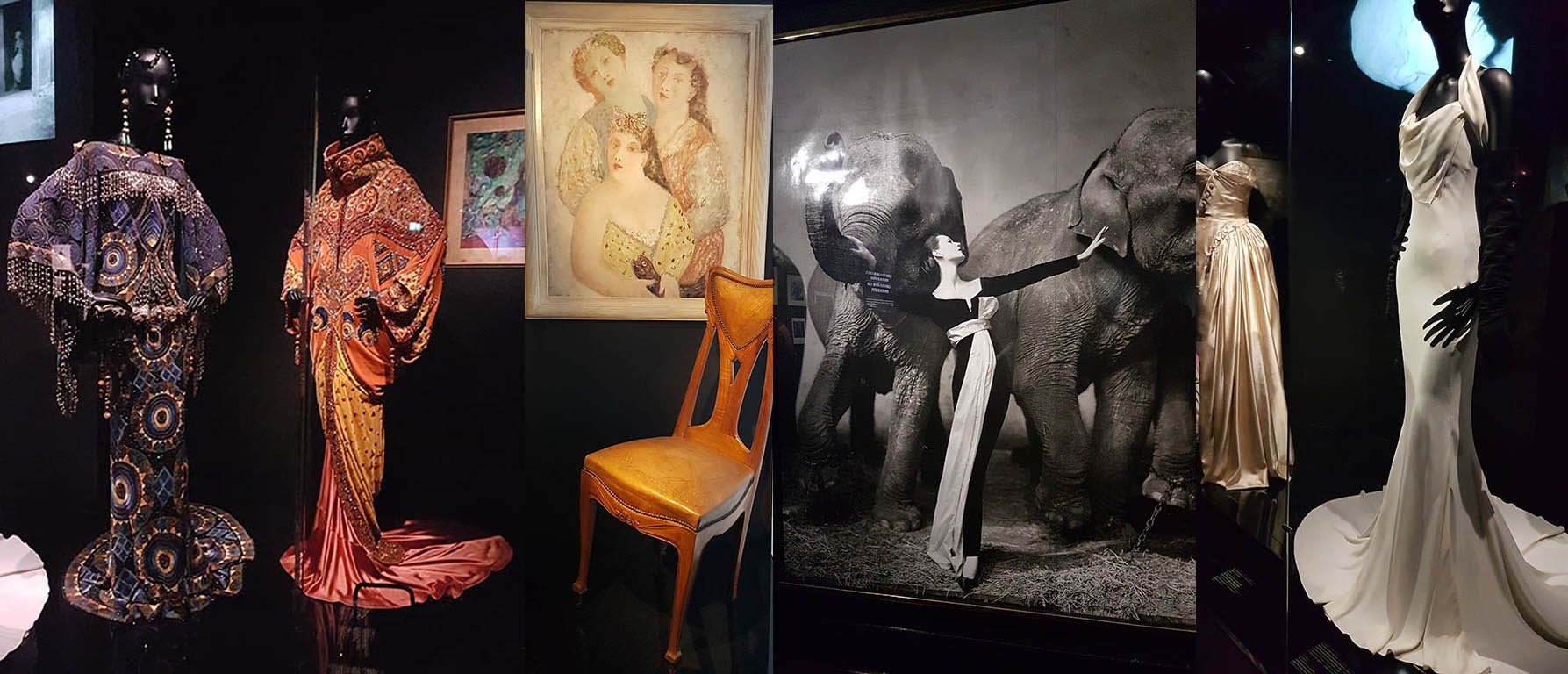
Art in contemporary form has always played a strong part in influencing style at the House of Dior. The early galleries of the exhibition show a series of paintings that are described as being from the Dior collection. Beyond the classical lines of many of the Houses' creations more elaborate play with colour and pattern can found. Dior may have been the House of the New Look but it certainly wasn't the House that showed just one look.
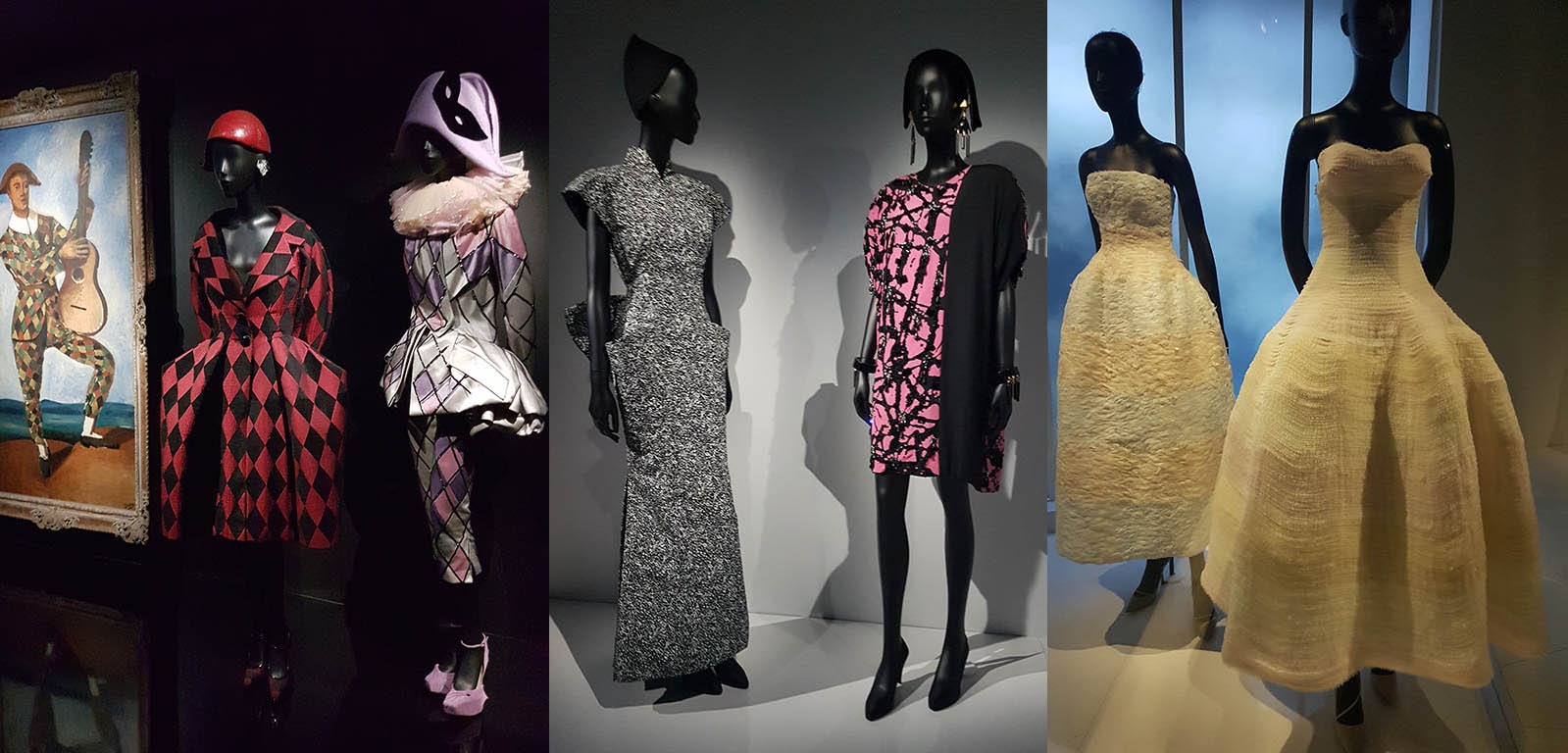
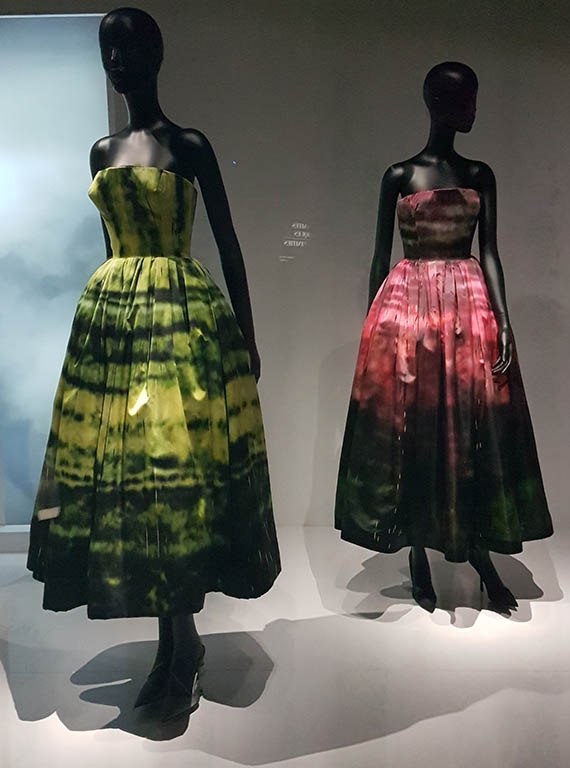
The Harlequin jester's outfit re-made into fanciful Haute Couture hints at modern masques and parties and has the fun and frivolity that is essential oxygen in the world of Haute Couture. To the right two evening dresses explore challenges to the conventional lines of style and design while still creating flattering dresses for the female figure.
These date to the 1980's when Dior was more than maintaining it's image as a leading Parisian Haute Couture House following the early decades of the 1950's and 1960's. The dresses to the right above show the more recent variations of the Dior New Look style under the watch of the House's two most recent designers prior to Maria Grazia Chiuri assuming the position of Creative Director.
A wonderful introduction to the atelier of Dior and the mind of the desiner was a lengthy passage of finished garments, accessories and fully finished mock-ups sometimes known as poupees (meaning dolls in French in an earlier era) that were created to give buyers and clients as well as Maison Dior staff a hint of what would be coming in the next season.
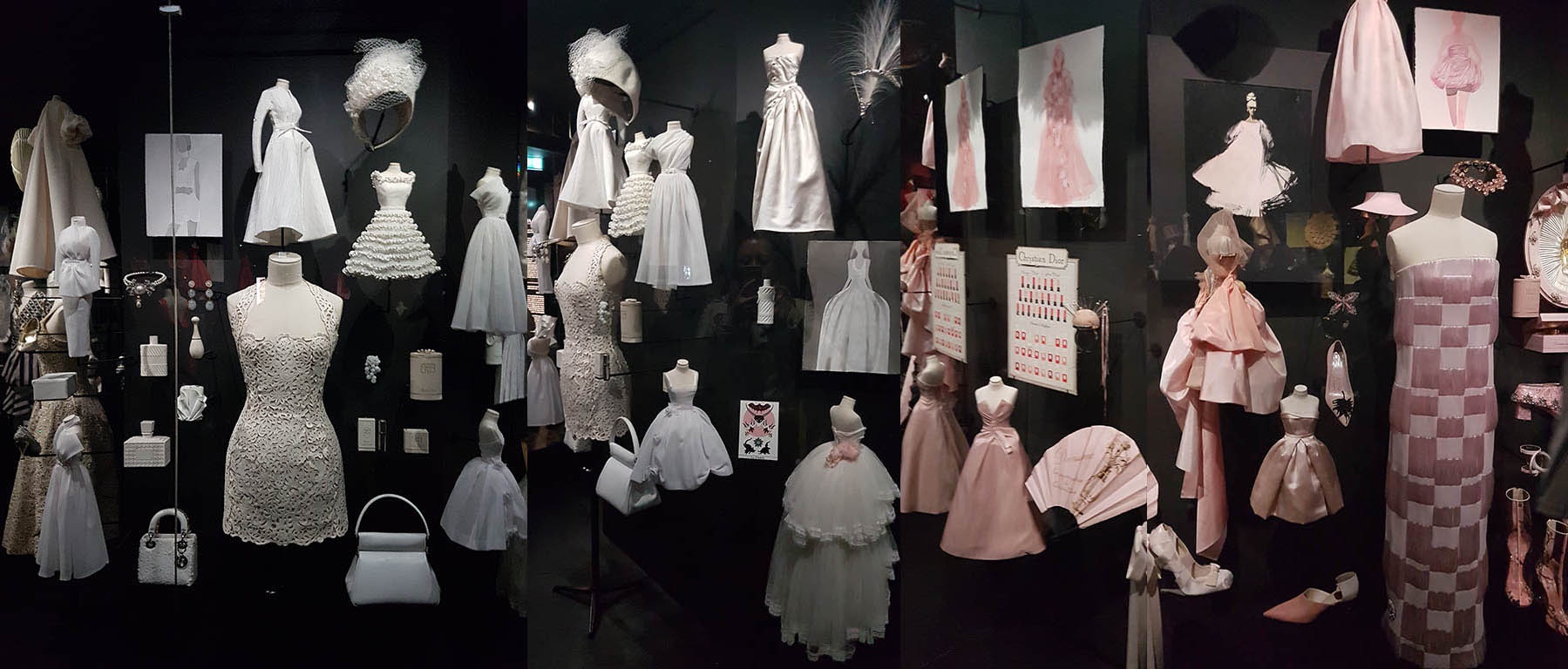
In an age before DVD and internet these where an excellent way to show three dimensional examples of what they finished garments would look like to selected audiences. To students of fashion history and many more, they are simply adorable in their own right and I would imagine any that slipped out of the possession of Dior would be highy collectable. In a colour palette sweeping the spectrum of the imagination of Dior, the frieze almost feels as though it could consititute and exhibition in itself. Every permutation of an evening dress that you could imagine across the 20th century is here, in it's home, the Dior archive.
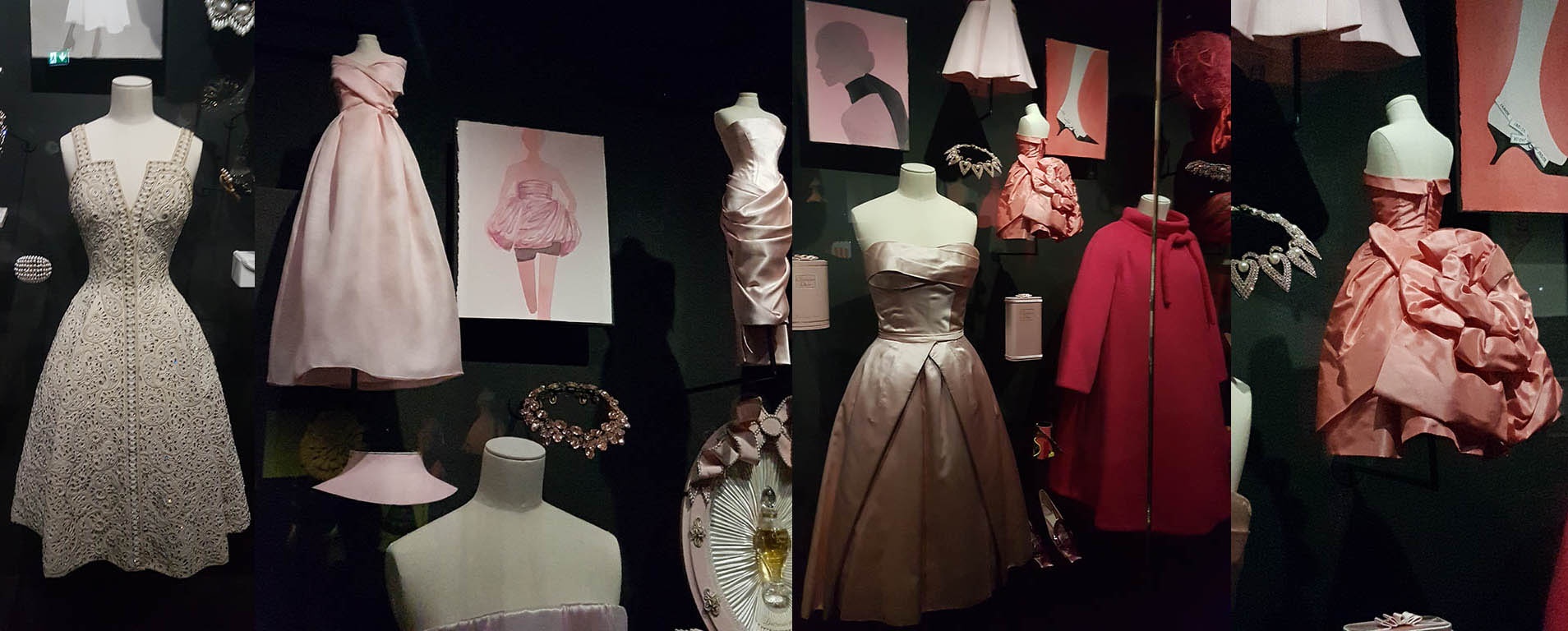
Both the life-sized and demonstration pieces show their ability of the Dior magic to take the viewer on a flight of fantasy, in the imagination to places and moments where they could wear the dresses. Also for many the clean-cut lines of the styles simply delight the eye in their sense of uniformity. There is an order in beauty that is hard to resist, even at the instinctive level. Fashion often runs in cycles, even if they are cycles that show adaptations and above to the right an Apricot dress from the later 1950's shows an adaptation of the elaborate bustle detailing found in the skirts of Parisian dresses of the late 19th century. Both costume and high jewellery have played a part in Dior's accessory repertoire over the past seven decades and many of the pieces are easily interchangeable with looks from across the Dior seasonal Haute Couture collections from one generation to the next.
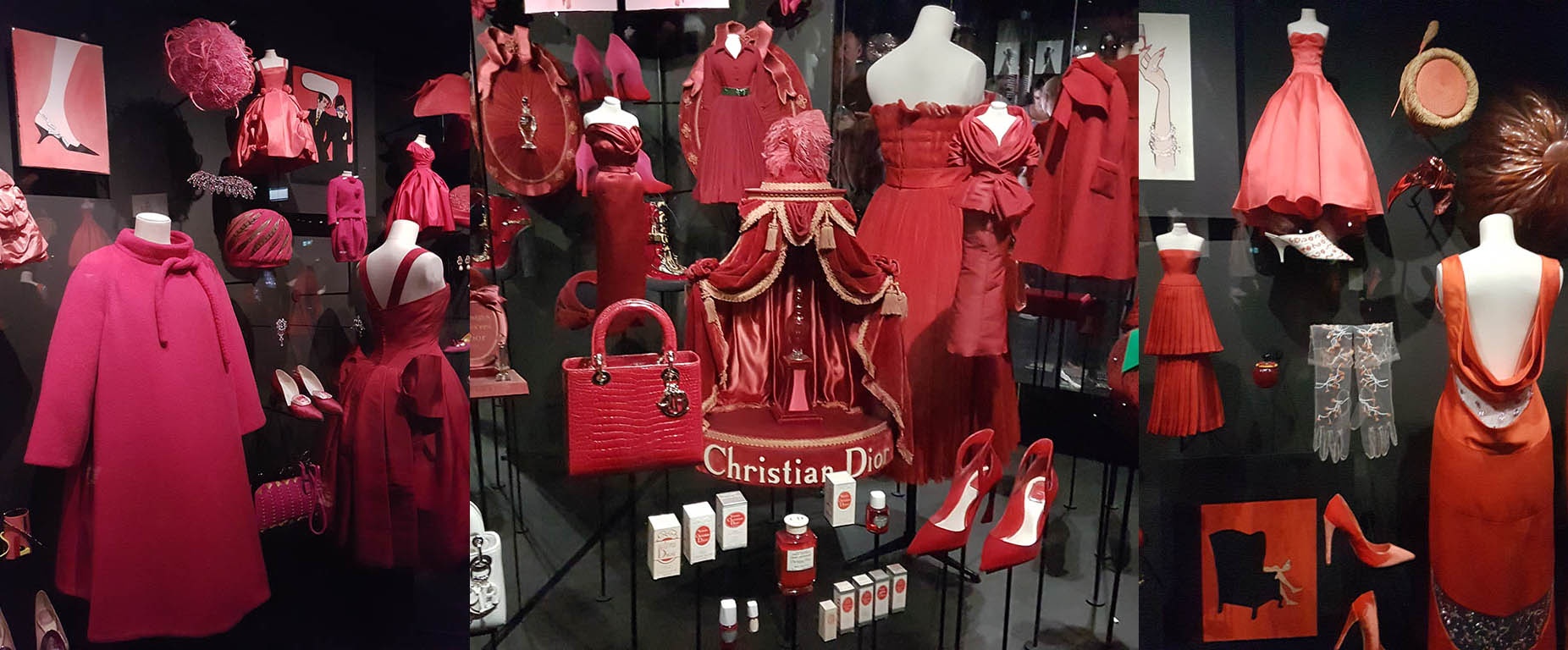
To place one garment or accessory after the next in the most subtle gradation of colour is like playing with the most glamorous 3D jigsaw puzzle that you could imagine. For fashion students, in fact even myself, it's a place where you feel the urge to get out the sketch book and start getting to know the shapes. It's tempting to look at many of the life-sized pieces and imagine wearing them today as this is the vintage wardrobe many of us would love to pick something from.
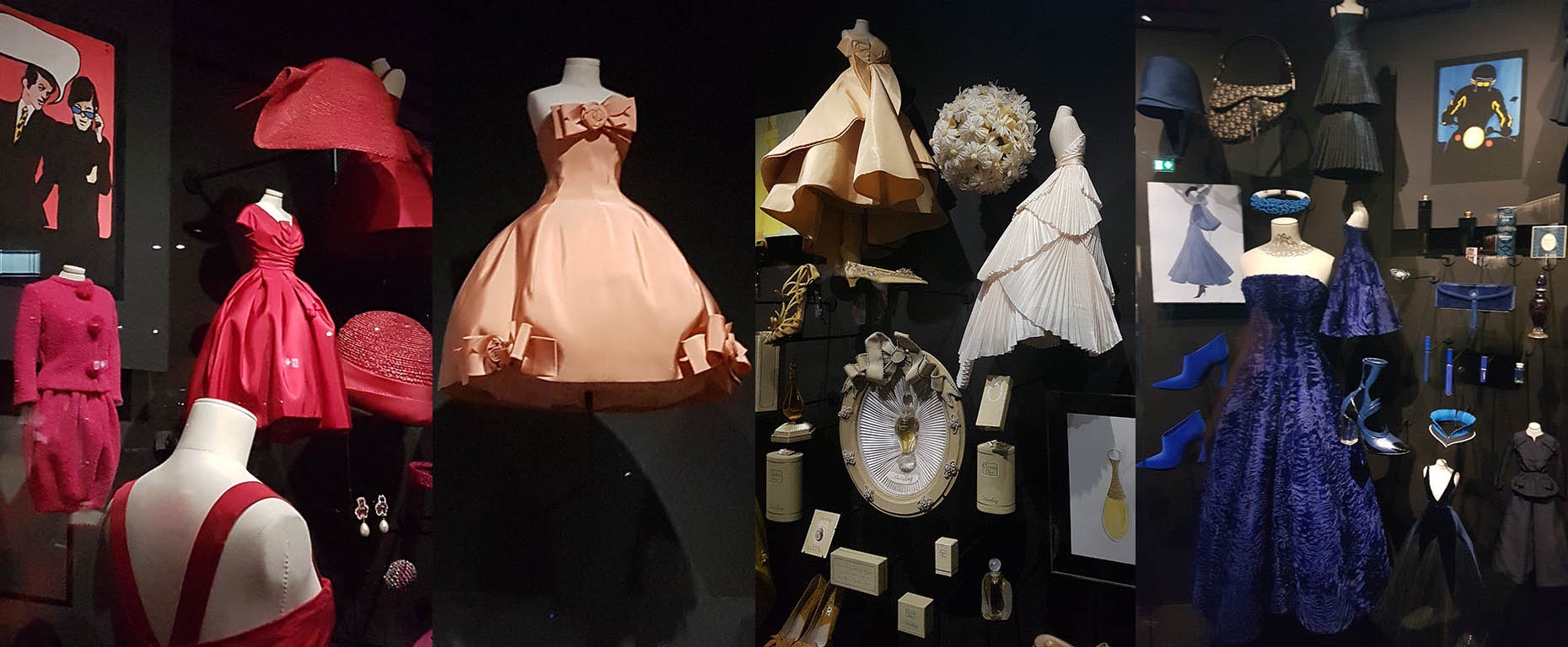
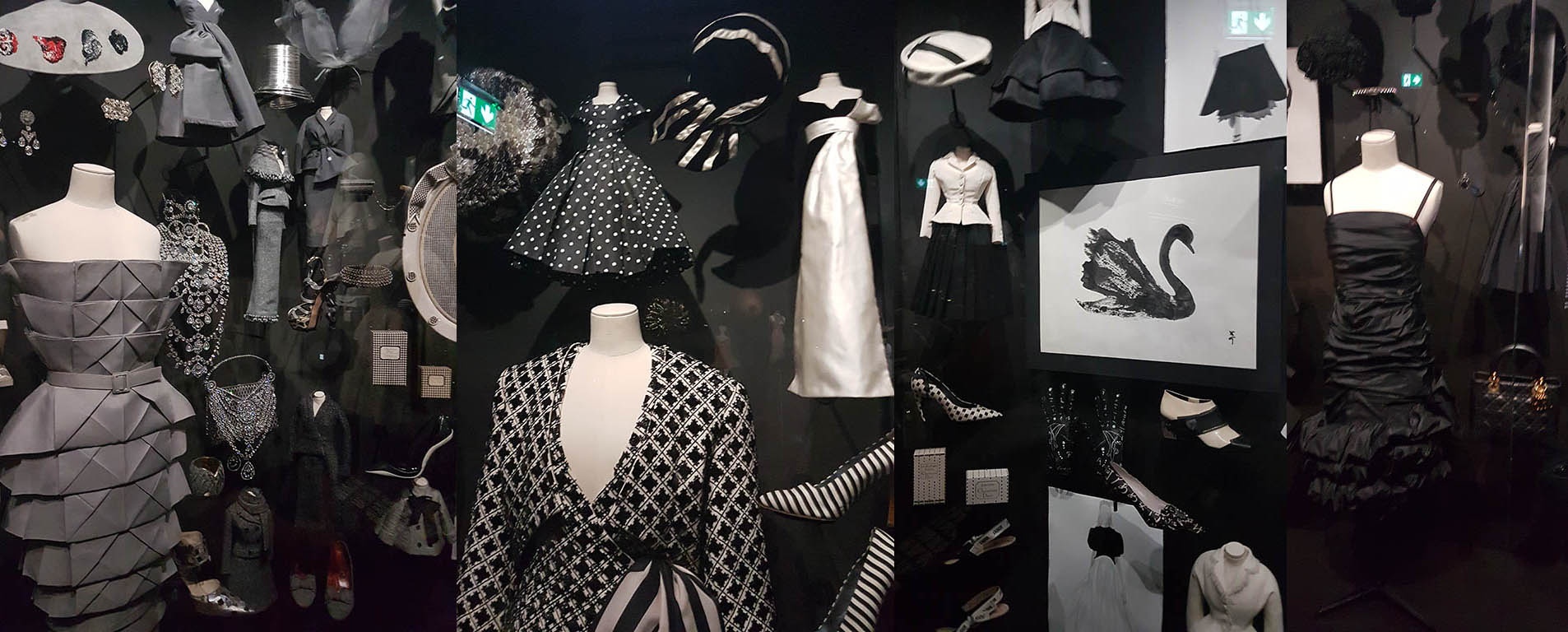
Dior dressed women with myriad different interests and influences and it would be wrong to see the cohort of his client base has having a collective identity beyond their wealth. The vast array of styles taken from the coloured series snapshot of Dior's heyday give testament to many different faces and places that saw the work of the atelier worn in. Even beyond the usual hues of colour favoured for evening dresses he manages to make Grey look interesting and creates both beautifully executed day suits as well as showing a conceptual cocktail dress that uses folds of oregami-like fabric to create a layered 3D effect. If you had ever wished to see a full over view of the repertoire of what a leading Couturier could offer a client in the mid 20th century this part of the exhibition is essential viewing. Also of great interest are the drawings featured showing design for dresses and early inspirations such as the swan print and neighbouring Black dress.
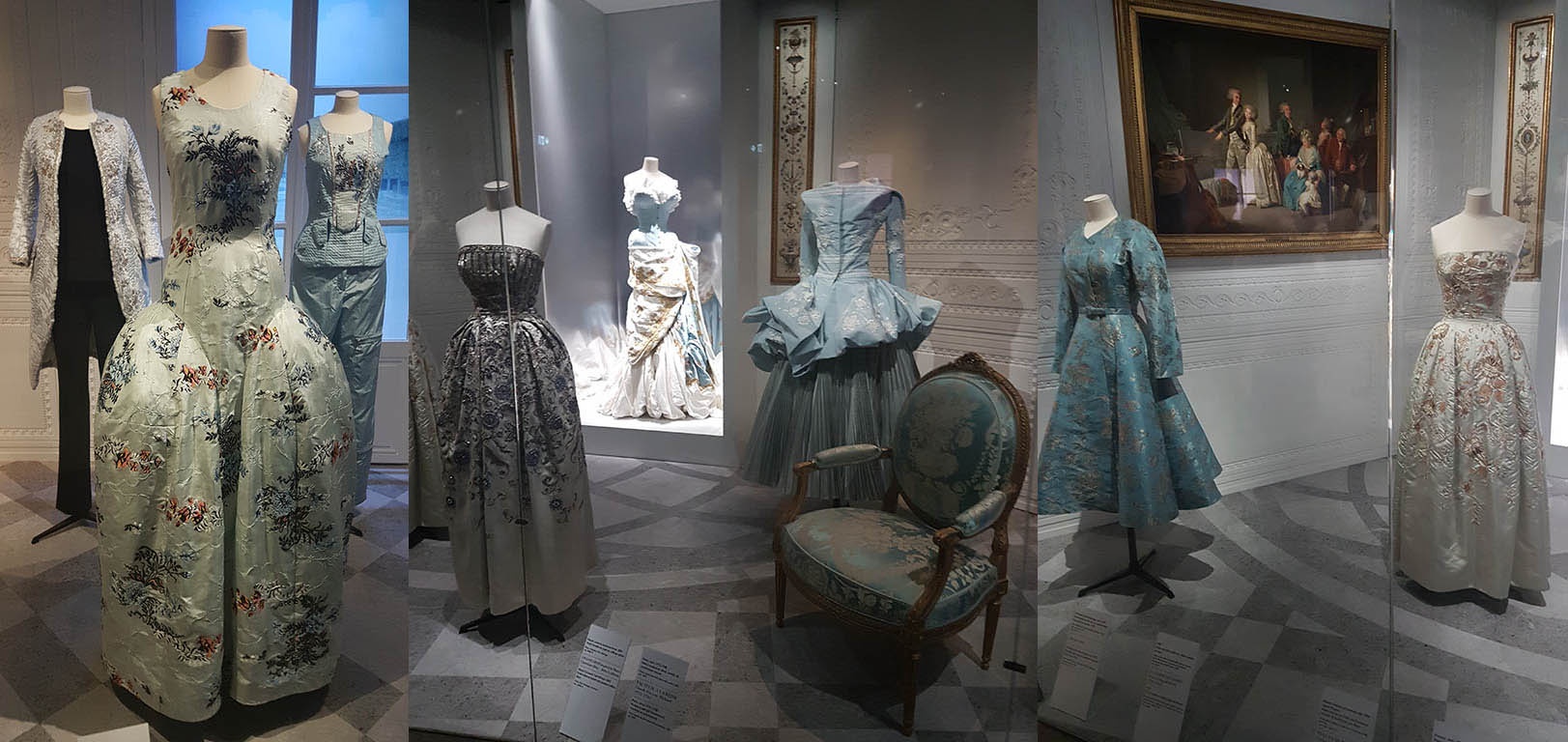
Delving into the rich and colourful history of Paris and France was another valuable source of ideas for Dior. To the left the arches over the hips of an 18th century dress skirt are dropped in an experimental high fashion garment that brings the bodice of the dress lower beneath the waist. Richly embroidered as clothing of previous centuries was, this look could be worn on a warm evening or with a cloak across the depths of a cold winter. To the left at it's shoulder, a variation of masculine style shows a long line frock coat transformed into a ladies suit jacket. This could also be worn with a complimentary single coloured dress but also looks striking with simple Black pieces that highlight the detail of the workmanship. To the right a sleeveless blouse and trousers in Light Blue silk offer a natural pairing with the jacket or could be worn alone separately and also channel the 18th and early 19th century mood of the room. This is a romantic era in terms of the beauty of the clothes that were created and sat alongside a politically turbulent back-drop. Dior have always been aware of the power of romance and the impact on clients imaginations.
Below a dress shown in a lit cabinet gives the full sense of appearance of the garments when shown under high lighting. In the foreground a Silver coloured dress with fine embroidery across the skirt and crystals lined across the bodice is a defined perfect evening gown. To the right a little experimentation appears with another adaptation from the male wardrobe as a man's outer coat is adapted in style and fused with an impression of a double layer of petty-coat in the coat lengths and pleated under skirt. Set in rooms deigned to evoke those of palaces or grand salons in Paris the clothes feel like they have the space that they require. An embroidered Light Blue coat dress sits next to the first of two dresses that appear to resemble the coronation dresses of Queen Elizabeth. Richly embroidered with flowers the first dress in White silk is perfectly accented by the light soft colours. To the right a dress covering the shoulders has a sash appearing almost as an apron around the waist with flowers in a chains emulating the ancient chatelaine keys worn by women.
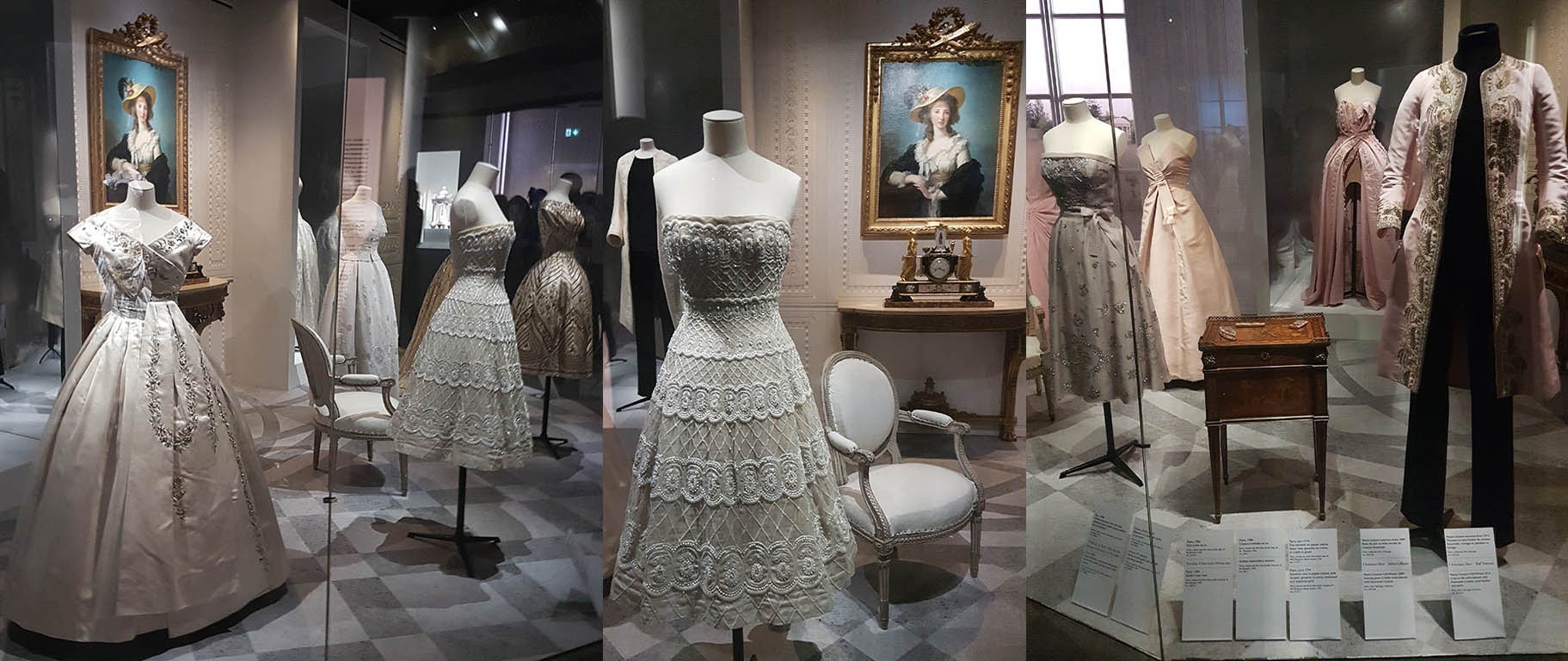
Lace is a wonderful fabric to craft into luxury garments, either as outer-layers or in detail and above to the left in a complete garment. With White and the very faintest hint of Green underneath this bandeau style dress can be worn alone with or without jewellery or with a jacket or wrap for cooler nights. It's a light piece sitting easily on the figure. To the right a re-imagined drawing room scene, like many of the tableau of the room show several figures turned as if greeting new guests to the room simultaneously. The light coloured dresses sit beautifully on the figure and offer a pretty sophisticated spring-summer series of looks. You can see in several places, bow-sash detail and its a simple motif that Dior employ in several places to simple, yet pretty effect in Peach, Pink and Ivory. To the right a Pink frock coat with Golden embroidery and trim show in closer view, more of the craftsmanship of the atelier. To the right in the foreground, another dress evocative of the Cream-Ivory silk coronation dresses that were created for Queen Elizabeth by Norman Hartnell as she celebrated the start of her reign across each of the Commonwealth territories. With it's intricate embroidery it's the equal of any piece that could be created to be worn at an official or state function. To the right a duet of Ivory and Pink looks show further expertise from the Dior atelier that has endeared the House to clients around the world for generations.
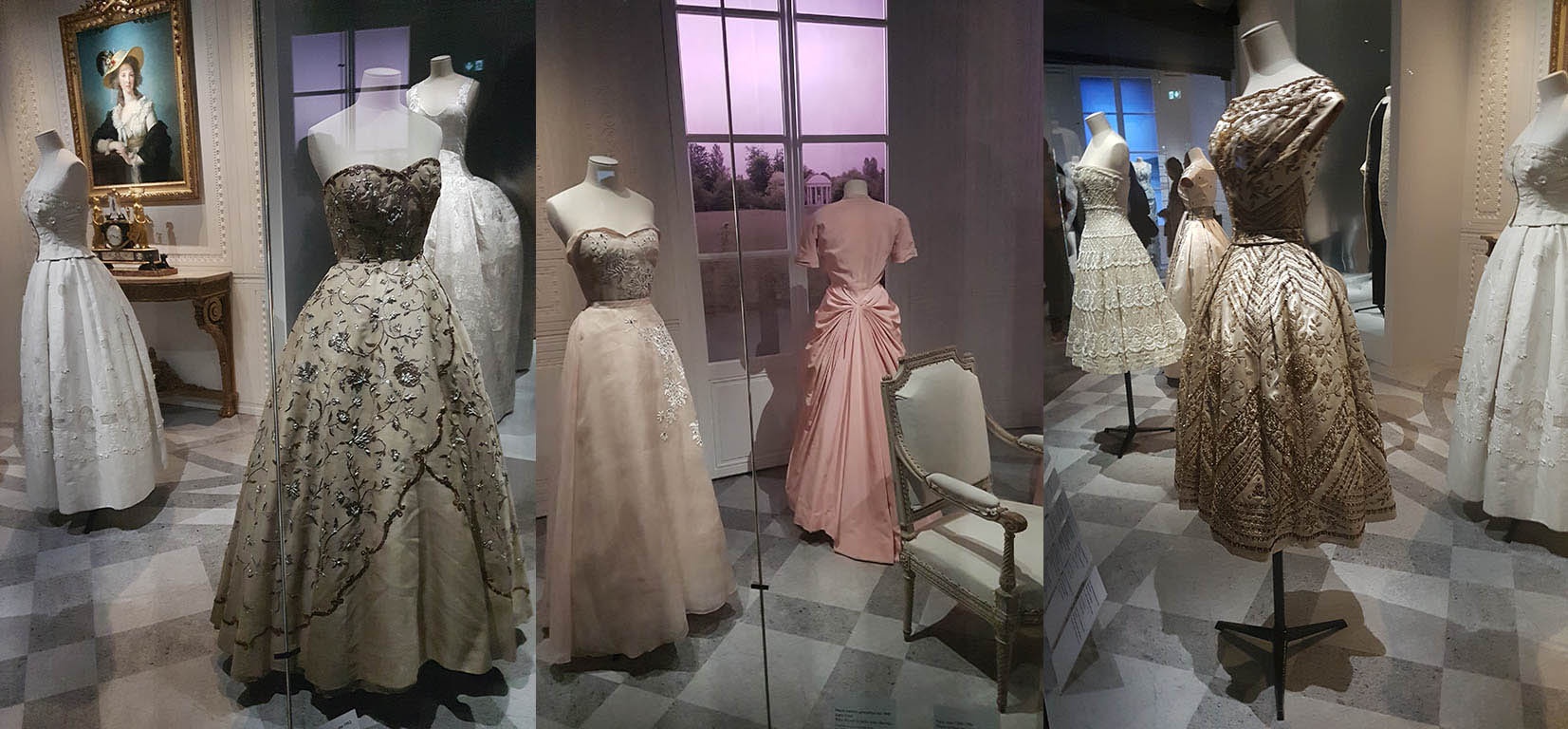
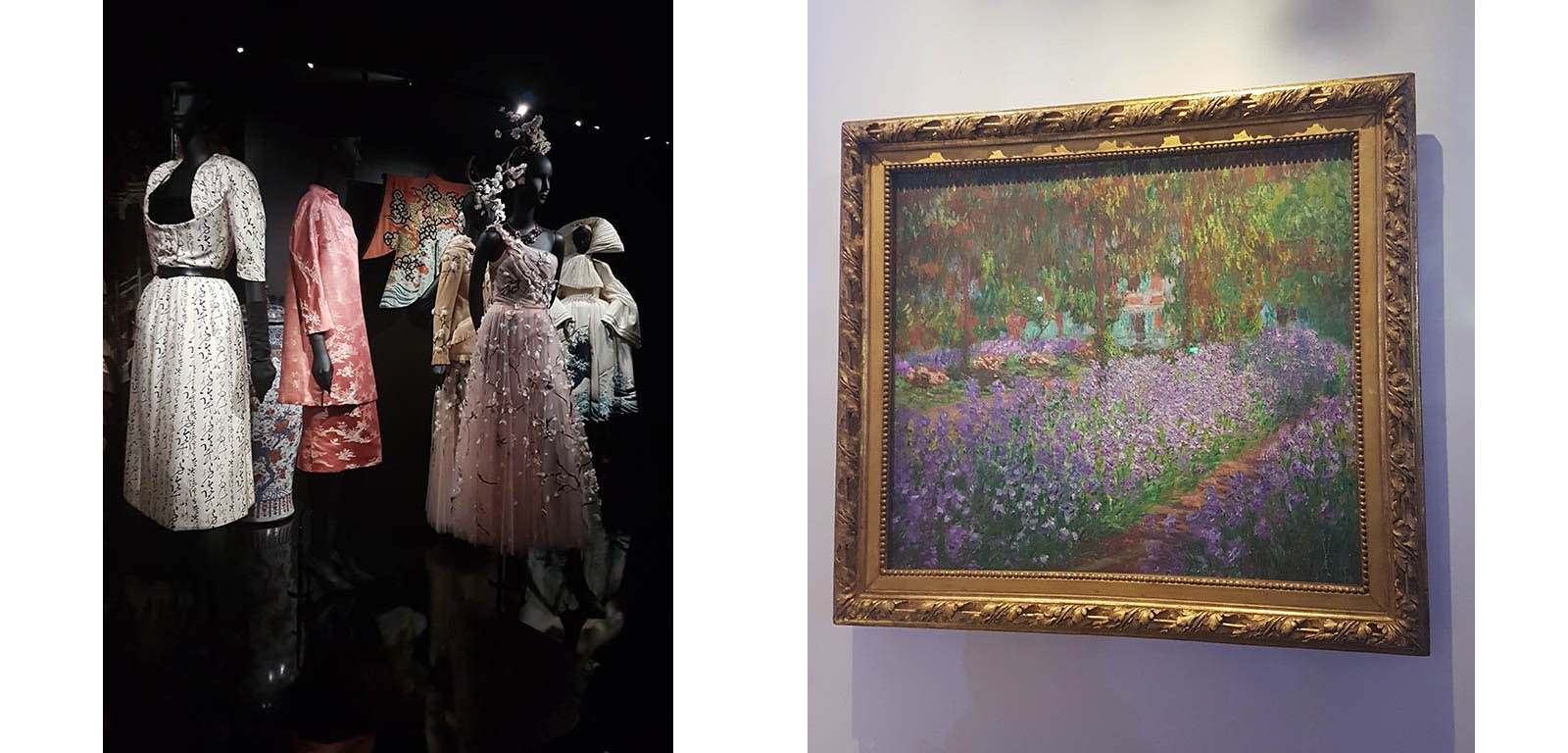
Moving forward the next series of pieces references the international travel tastes and inspiration behind Christian Dior. China and far East Asia feature subtly in the collection with references to Cherry Blossoms, silk prints and also Chinese script writing. In the background above a robe hangs with fabric at full extension as if worn to show the full beauty of the garment. Whether evening dresses or flights of design fancy to be worn by clients, these looks all encompass imagination and passion. To the right a work by Monet shows the floral feel behind many of the influences to the works below. The inspiration was also often jointly taken from Dior's garden at Granville in Normandy too, begun by his mother it was one of his earliest mediums by which to explore colour.
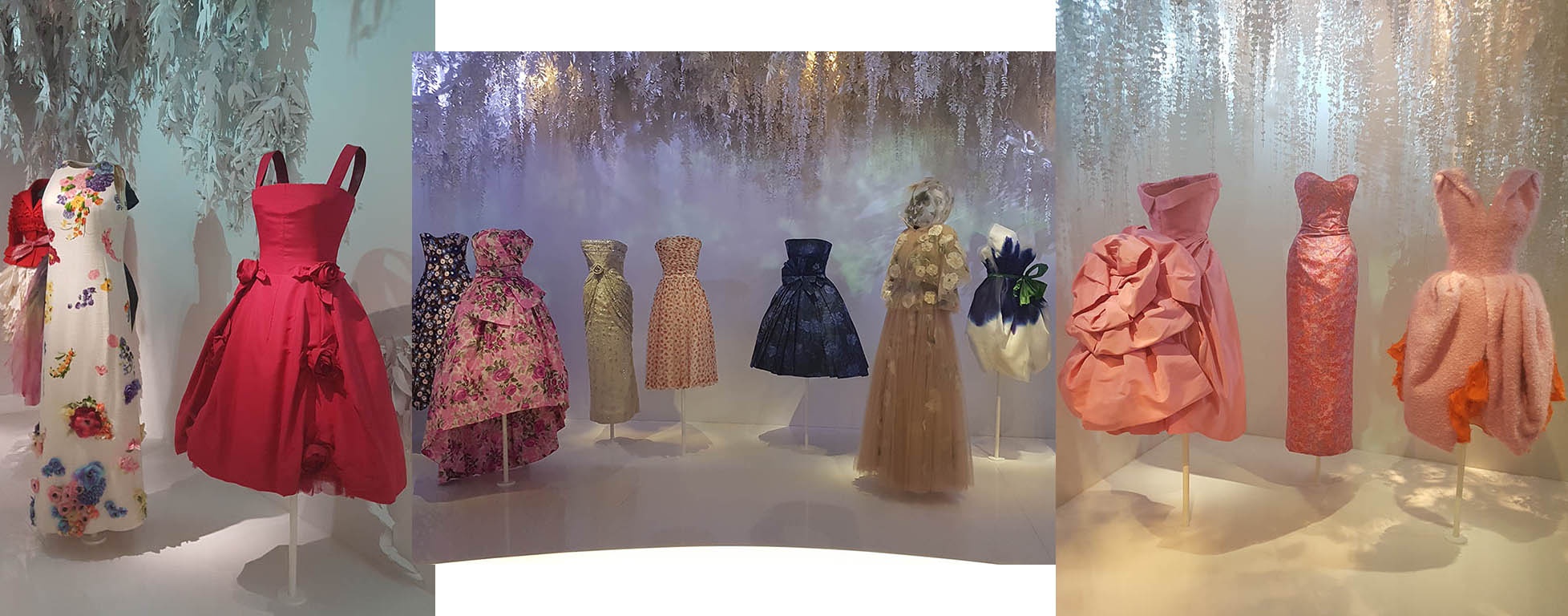
The above is a series of some of the chicest cocktail dresses that you could imagine and notably again there is plenty here to interest a wide variety of tastes across a diverse international client base. Above to the left two dresses in the foreground in a contrast of single colour and floral print illustrate the hugely diverse canvas that a fashion designer has to draw on for ideas for formal wear pieces. A Magenta-Red dress with beautiful rosettes descending the length of the skirt to the knee is an easy piece of elegance that has a beautiful sense of humour and fun about it. To the left it's neighbour with long lines and sleeveless appearance looks slightly less formal and channels the era of the late 1960's and early 1970's.
The floral series in the centre offers a sweet selection of designs from the garden for both day and evening wear options. You can see the full span of Dior's library of creation from the early shapes taking their cue from the Bar dress to the tulip style dresses of the later part of John Galliano's era at the House. Haute Couture dresses women of all shapes and sizes with relish and care and you can see here a number of different styles that would suit so many women. To the right a Rosy trio features one of the dresses with a rosette style bustle, the ultimate statement cocktail dress and to the right it's companions work the contrasting lines of figure hugging and tulip-head shaped.
Below three of the dresses in close-up show the mastery of skill that the atelier of Dior can bring to the vision of both designers and clients. Each piece is a masterpiece and if it were not in a museum, would be something to treasure and perhaps pass down through a family as many clients do. Shown in the round, each is an off the shoulder dress in the bandeau style that became popular in the mid 20th century along with similarly neck-lined swimwear as conventions loosened. The attention paid to the floral detail is fascinating and truly deserves to stand alone as art work. Garments like these in their beads, jewels, fringing and drape show you exactly why some people collect Haute Couture as other would collect art.
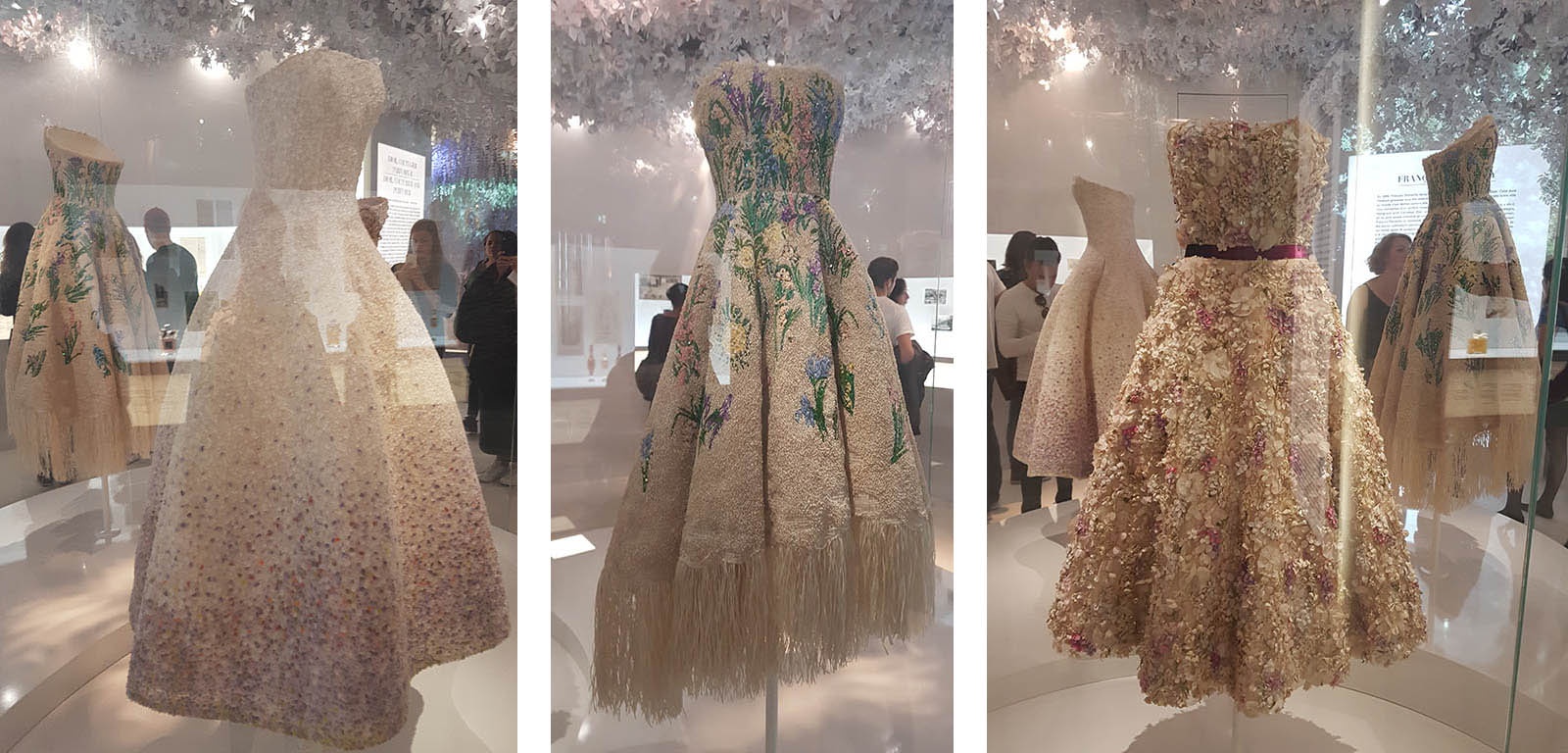
In a quiet moment above a staircase in the exhibition, Dior showcased the impressive series of covers that they can credit to their name. It's a poignant moment the span of era's reflects the brands consistency. Something to stir many memories. Dior sits at the heart of conventional Parisian Fashion but often takes the opportunity to show it's humour too. To the centre below a fur coat from the 1960's in ice cream colours with a Grey hem and diagonal of the Eiffel Tower makes a carefree statement. At the entrance to the double galleries of the exhibition the 'Bar' suit, shown below to the right, famed from Dior's well publicised post war 1947 launch stands with classic quiet elegance as a signature theme for the wider exhibition itself.
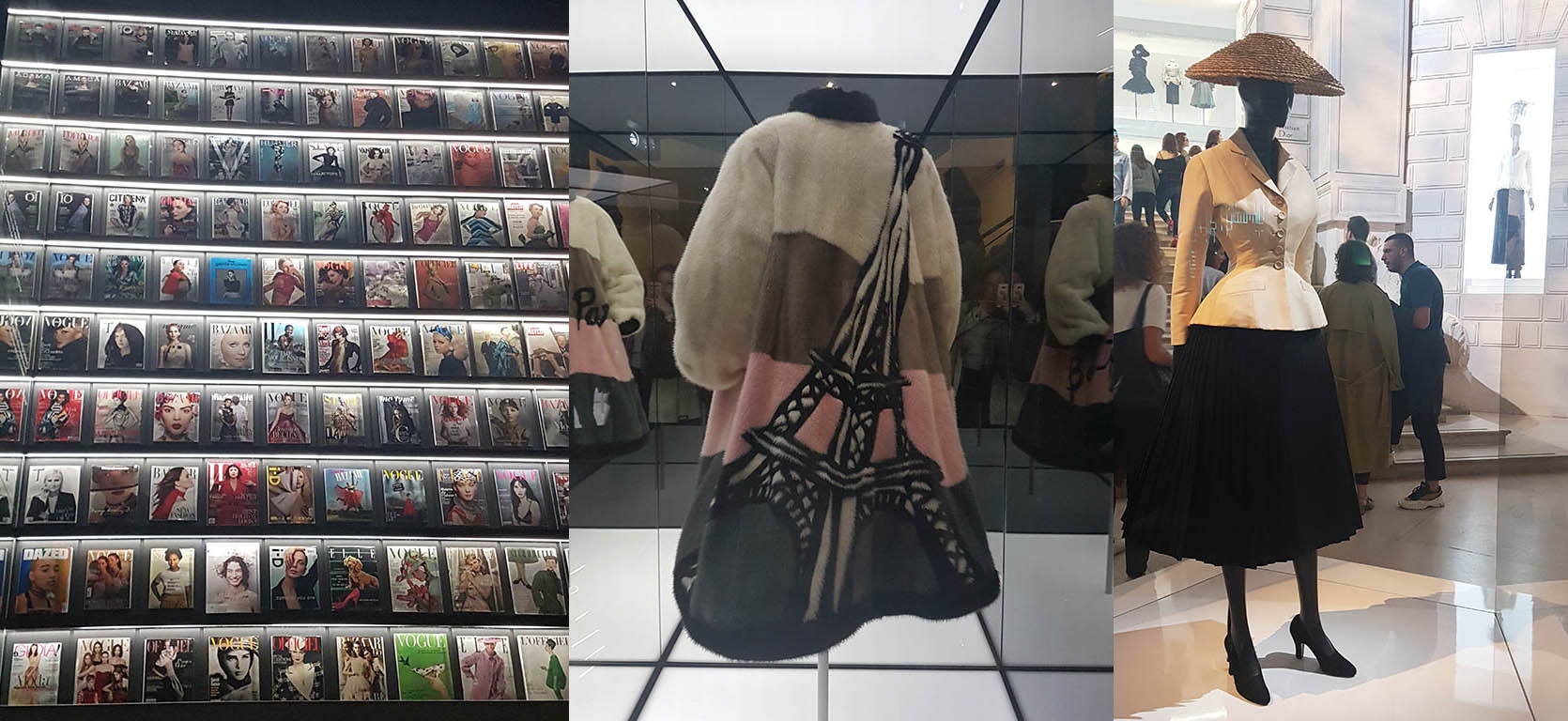
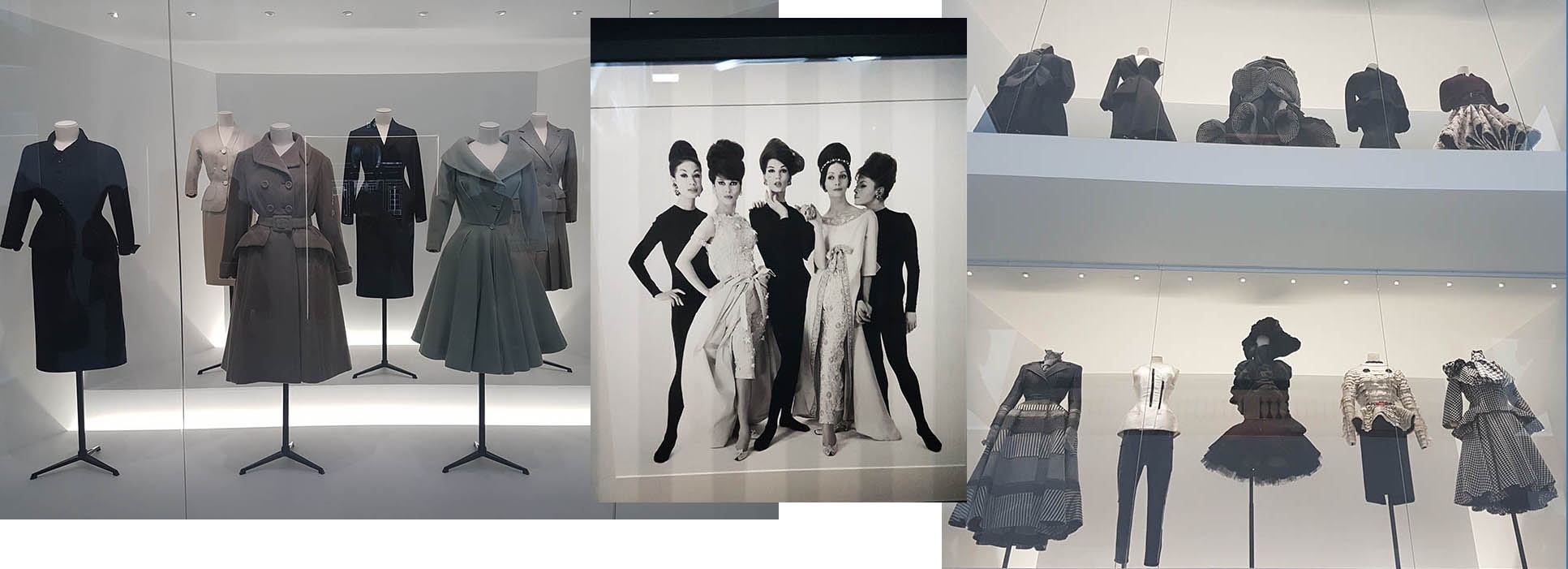
Taking the white walls of the atelier as an inspiration for their back-drop the next series of rooms showed finished garments in Grey and Black in a sympathetic tonal display. Dresses, day-suits, coats and formal wear from across the 70 years of the House so far. To either side of the 1960's Dior girls above you can see one cabinet of conventional classical Dior style and to the right more recent pieces exploring a conceptual side to Dior without losing any of the frivolity or excellence that clients expect of the House. Although clearly vintage, again you look at the garments and feel that you could see someone walk by your wearing them or see them offered for sale to eager buyers in a specialist auction perhaps.
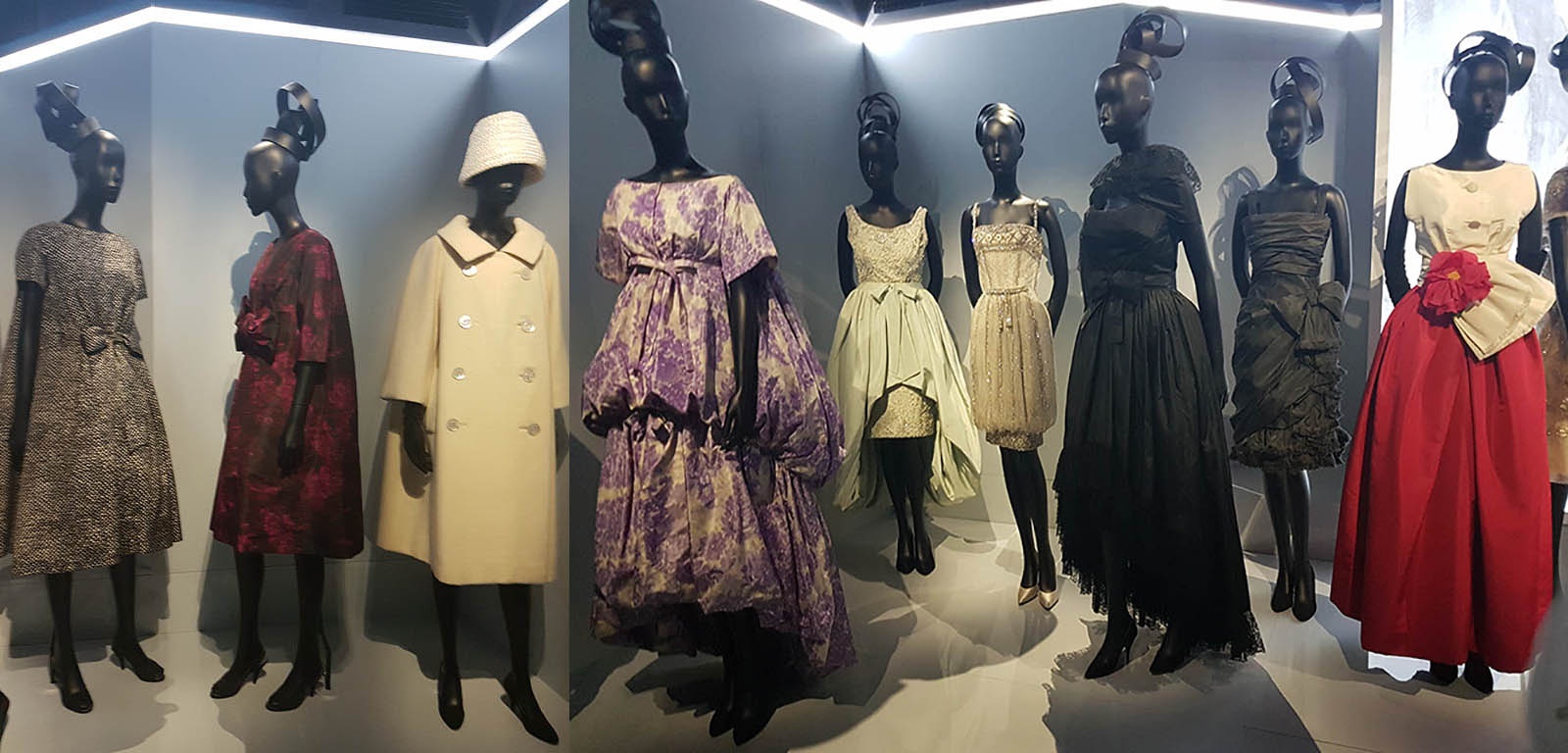
The many era's of Dior are explored in series of rooms that focus on the work of each designer who came to the House and added their own touch of magic following the legacy of Mr Dior. Above to the left the work of Marc Bohan who lead Dior's creative direction from 1961 until 1989 giving him, so far, the longest tenure of a name at Dior's helm. Dior's sweet bows still feature above the waist in a lightly dappled and Burgundy water colour print dress. Cut to just above the knee, they offer generous freedom to the figure in contrast to the restrained styles of a few years earlier. A Cream coat and hat (possibly recalling the plant pots of Granville - unless this is just me thinking of gardens!) offer both comfort and simplicity to the client with the jacket almost universally able to coordinate.
Echoing Balmain, the next dress in Lavender to the right is a classic piece of 1960's Haute Couture that shows a leap of the imagination with the feel of establishing new conventions rather than breaking completely with the past. Perfect chic cocktail and Black-Tie dresses stand by it's side but as ever, these are not all for the youngest of Dior's clients by any means as the designs in many cases lend themselves to being worn by women across the generations. Light laces, silk gazaar and taffeta weave around the figure in a musical harmony celebrating the beauty of women. Knee length double skirted Golden thread dresses look the natural companions of dipped hem and knee length Black dresses by it's side as if they could be a the same party.
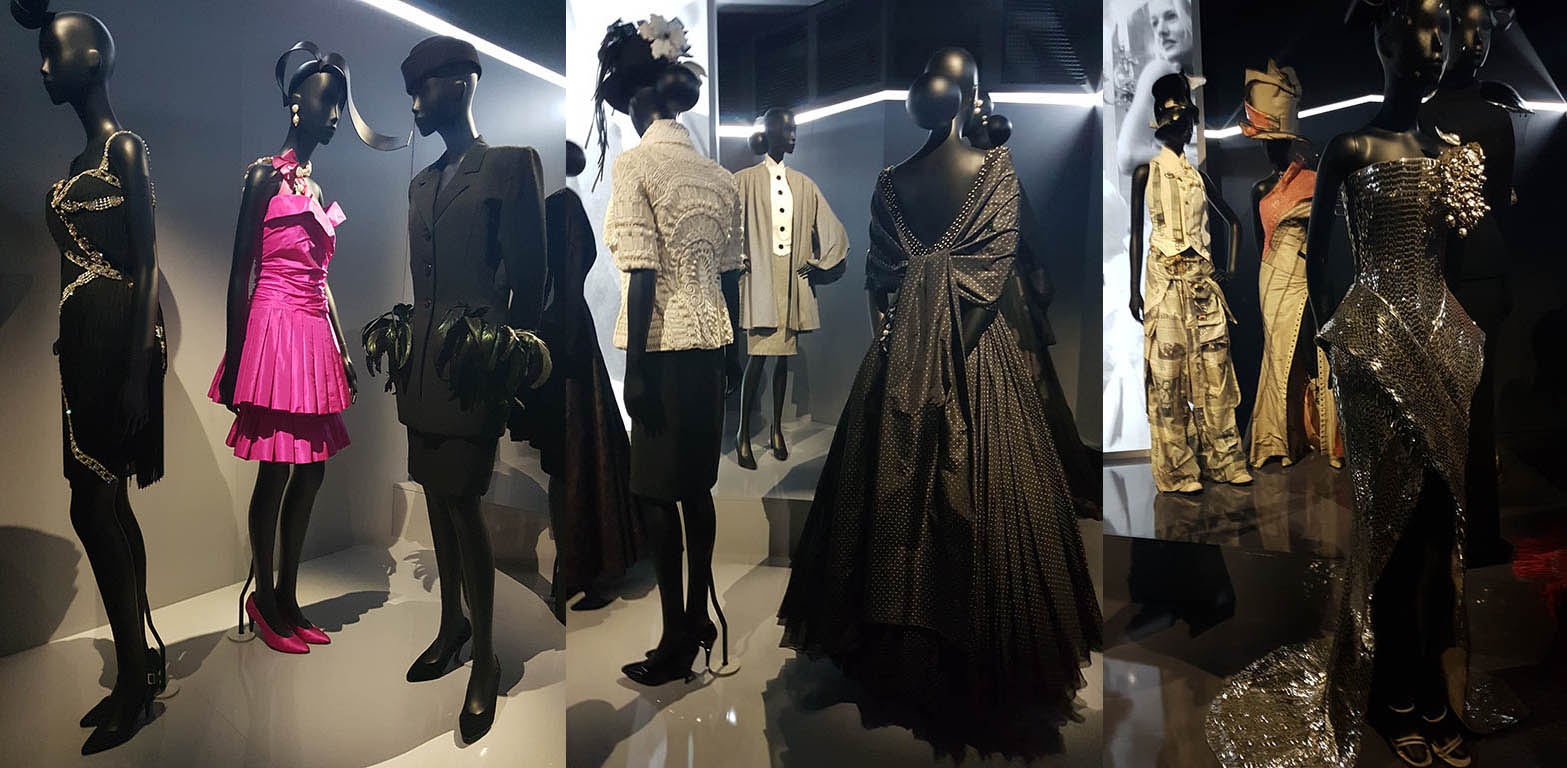
Sharp edged lines of the sleek international style of the 1980's and early 1990's are unmistakable in the looks above to the left. Cocktail dresses and a day suit finished with feather plumes at the pockets typify the fresh look to high glamour that the era had and Dior was right in the forefront of creating this luxury style that defined an era. Centre above a day suit cosmopolitan enough to be worn by any woman around the world stands behind a formal wear suit of Black skirt and elaborately embroidered White jacket. In the foreground a beautiful ball gown shows the attraction of designers in the 1980's in recreating the broad skirted looks of the 1950's and early 1960's. An era that Dior was perfectly placed to reference as the House itself defined the era.
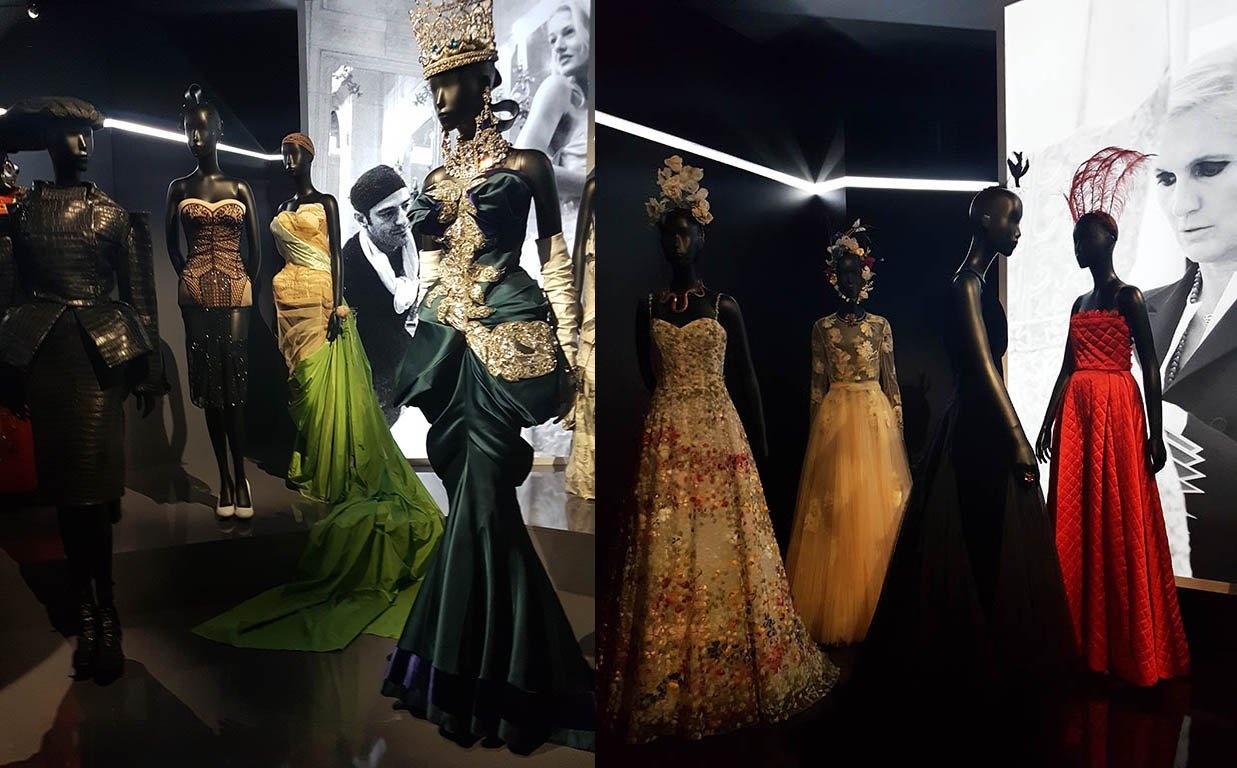
Above to the right and here at the left, the work of John Galliano showed that the skill's of the Dior atelier were up to the challenge of meeting one of the most powerfully creatives minds to ever run a French fashion House. The dreams of Galliano that came down the runway shot like a comet across the collective consciousness of the fashion work and after a small lull in the early 1990's in the world of Haute Couture, Galliano ensured that Haute Couture and the world of Dior maintained it's position and even gained ground in the eye of the public through the world's media. John Galliano's dresses made front page news around the world season after season and inspired countless young designers as well as satisfying clients across the globe.
Maria Grazia Chiuri is the latest name to lead the House of Dior and her installation as the first woman to head the House following her departure from Valentino was seen as a welcome new step in the industry. Mindful of the traditions of the House, she has quickly adopted a style that references the best of the past with fresh touches for the future. Keeping the clients engaged from one generation to the next is key and for Grazia Chiuri following her success at continuing the light and energy of the founder of Valentino following his departure she has already proven that she is both a worthy custodian and assured innovator.
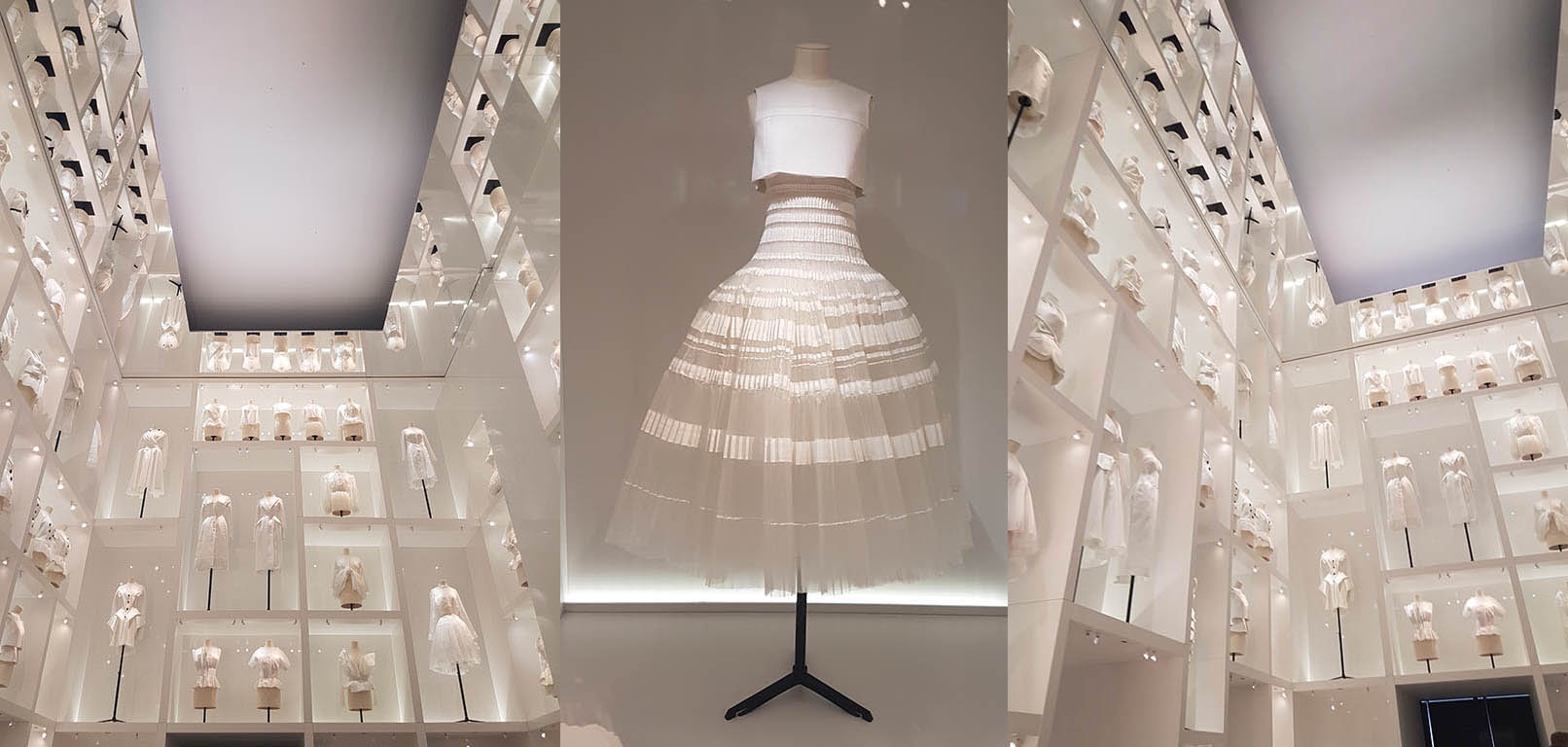
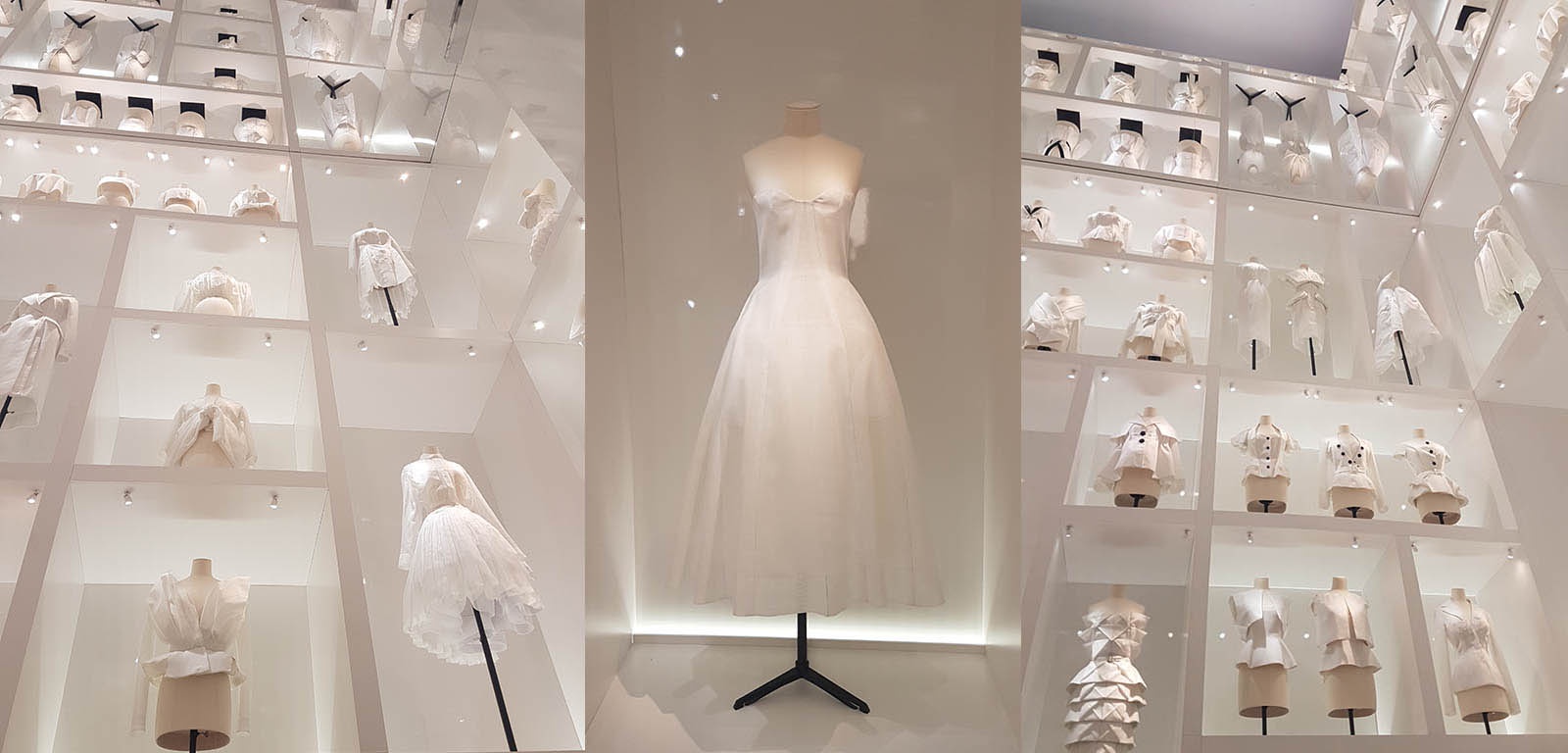
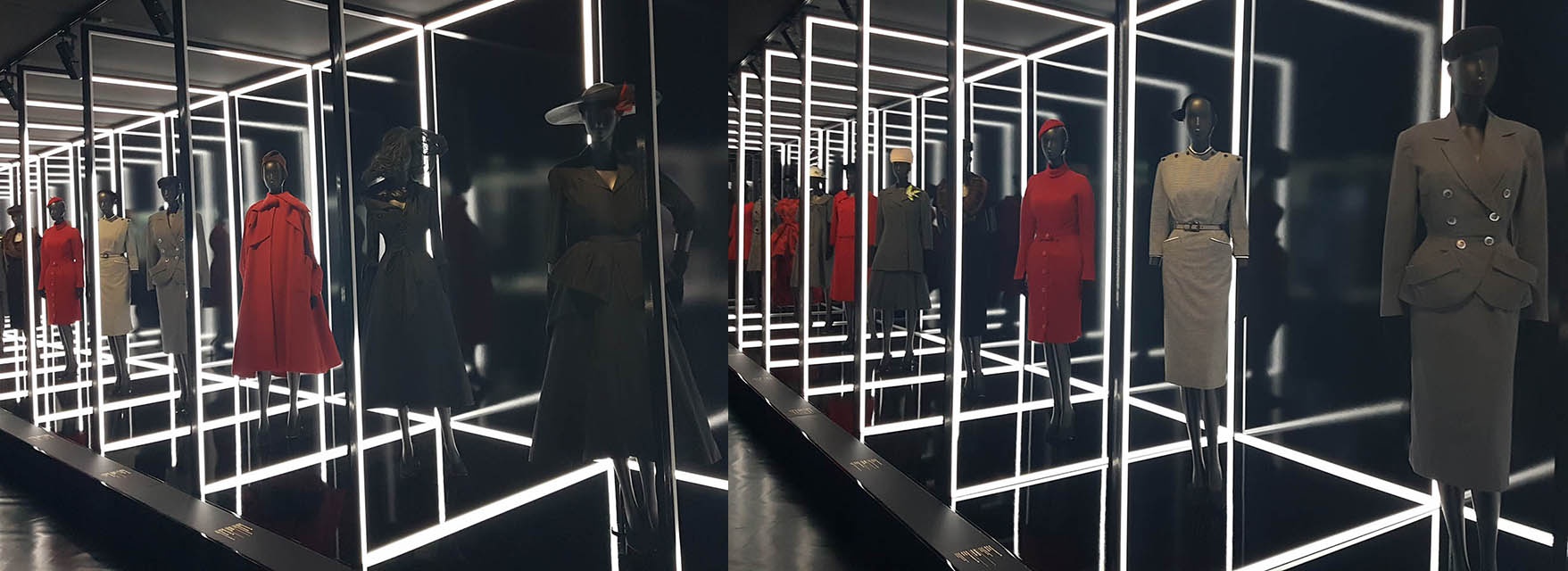
One of the most striking room arrangements I've ever seen was used to show an assembly of day and evening wear from across the seven decades of the Houses life so far. Sharp suited in skirts and coats (never trousers) this room was a powerful summary of how influential Dior has been in shaping fashion and the popular consciousness across the 20th and early 21st century. Strictly coded across a handful of colours Black, Red, Charcoal and Grey it shows the flawless perfection that walks forth from the Dior ateliers. Broad brimmed hats and their cloche and pill box counterparts show the attention that Dior has always paid to millinery in British style. Notably John Galliano continued this work with his long term design collaboration with British milliner Stephen Jones. The clothes speak for themselves in many languages and for many of us this defines part of the basis of what we know as formal wear style in the modern era. Above the classic looks of the earliest years of Dior are the obvious antecedents to the legendary Dior Red riding coat created by John Galliano for the Spring 2010 Haute Couture collection and the glamorous cocktail dress at it's shoulder. Having found so much inspiration to take forward from the early codes of the House, there is an ever expanding archive in effect for Grazia Chiuri and others in the far future to draw from as they continue the work in Dior's style.
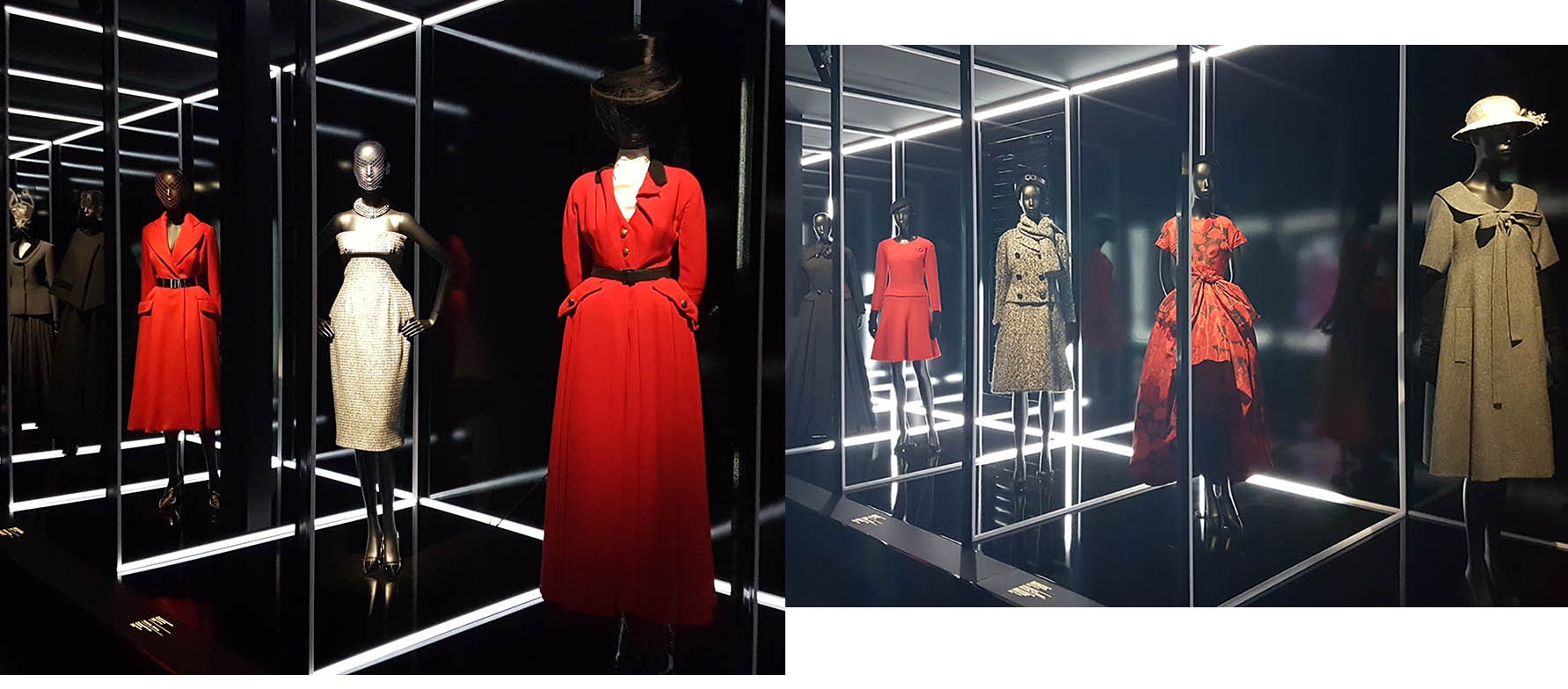
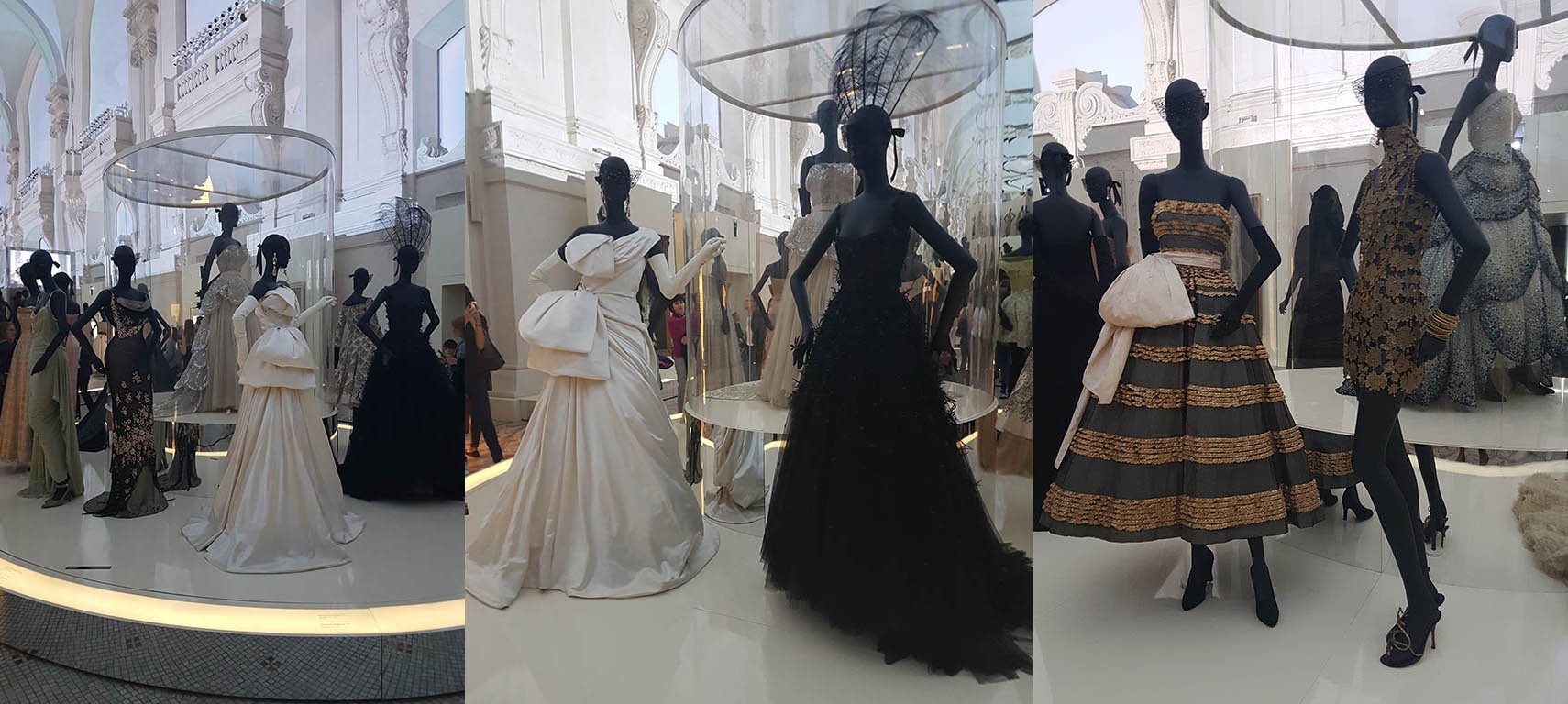
The finale room of the exhibition is suitably grand for a House that has designed dresses worn some of the most opulent spaces in the world. In a large hall of the Museum that originally formed part of the palace of the Louvre dozens of dresses were arranged on dais' shaped in the Dior oval cartouche. Spanning all era's it felt like this room was a pure celebration of women's strength expressed through the language of glamour. Any one of the dresses shown could be a personal landmark in the life of a wearer and many of the garments, notably the White floor length dress with a bow draped from shoulder to waist, is a piece that looks contemporary and regal. It could well be the long gloves that really do add an extra touch style but rarely worn these days. On cold nights they are however quite handy. Again through this incredible collection of design you can still see the mark of Dior's reserved use of colour. Generally only one or two in a garment that is often what the eye recognises as stylish and elegant.
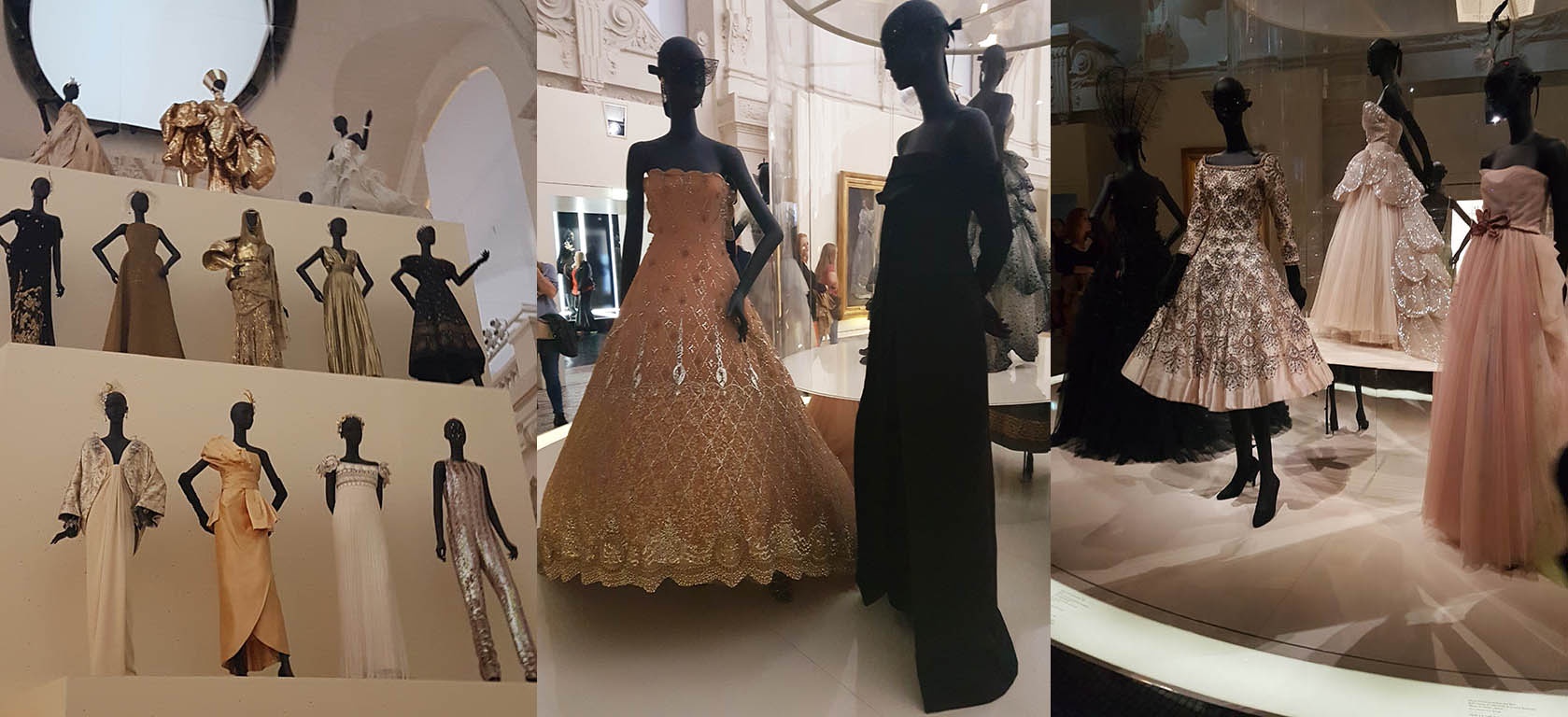
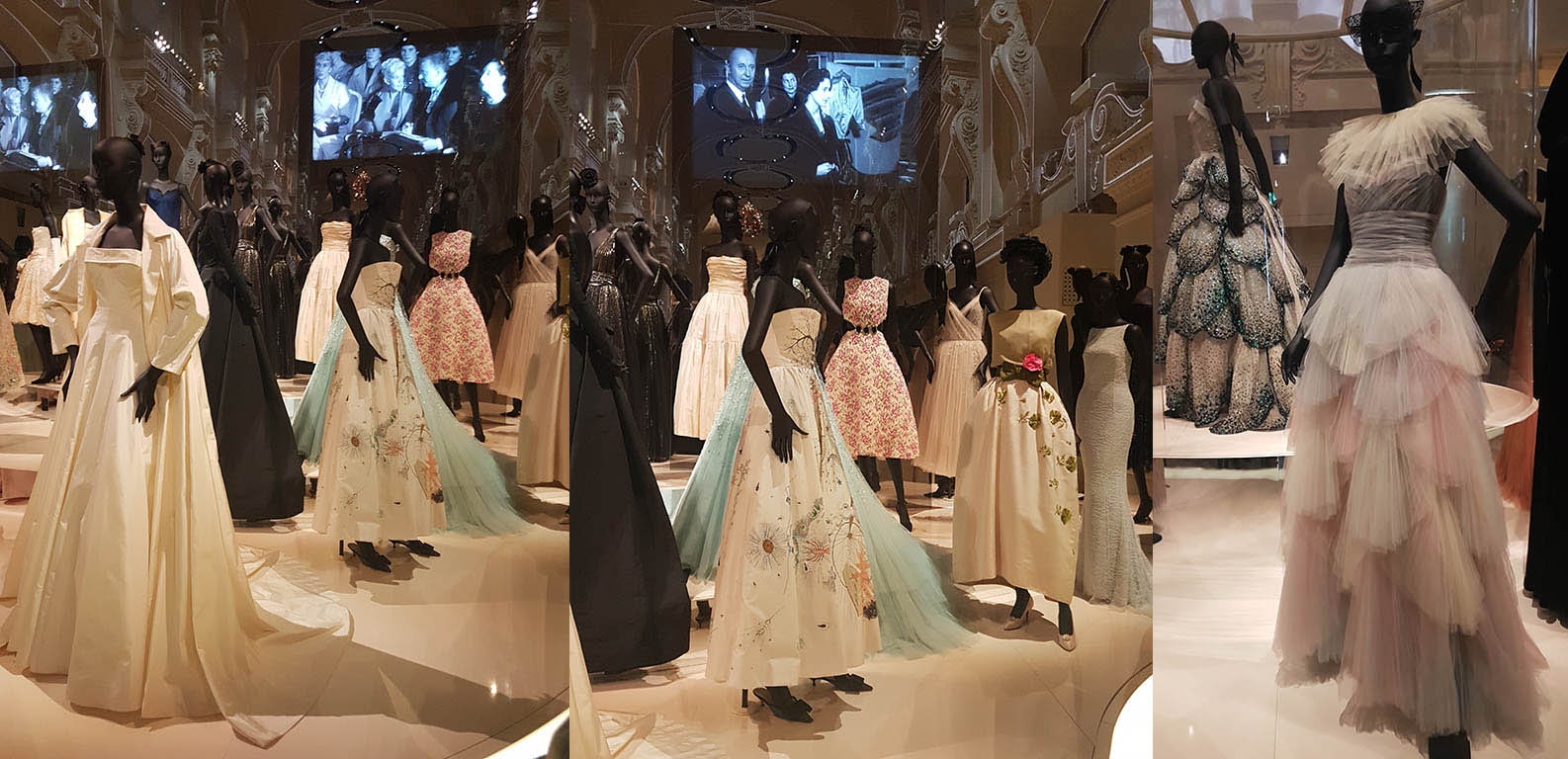
A group of models at the far end of the impromptu ballroom modelled dresses that included some that were shown at the two Blenheim Palace fashion shows held by Dior in the United Kingdom. With Princess Margaret appearing again as a supporter of the shows in 1954 and in 1958 the House aligned itself with a strong style ambassador. The colours of the dresses are beautiful to see against the backdrop of the Black and White films. It's a special experience to be able to see so many dresses from different collections together in one space. Flowers, embroidery, crystals hand sewn and crisp folds. To the right above two dresses with scale like folds in their skirt lengths make a playful twist on convention. Also not afraid to experiment with fashion and how it could be adapted, Diana Princess of Wales was a private client of Dior alongside British labels and relied upon their expertise to support her work with some unique gowns and as a thank you the House notably created a tote bag in her honour.
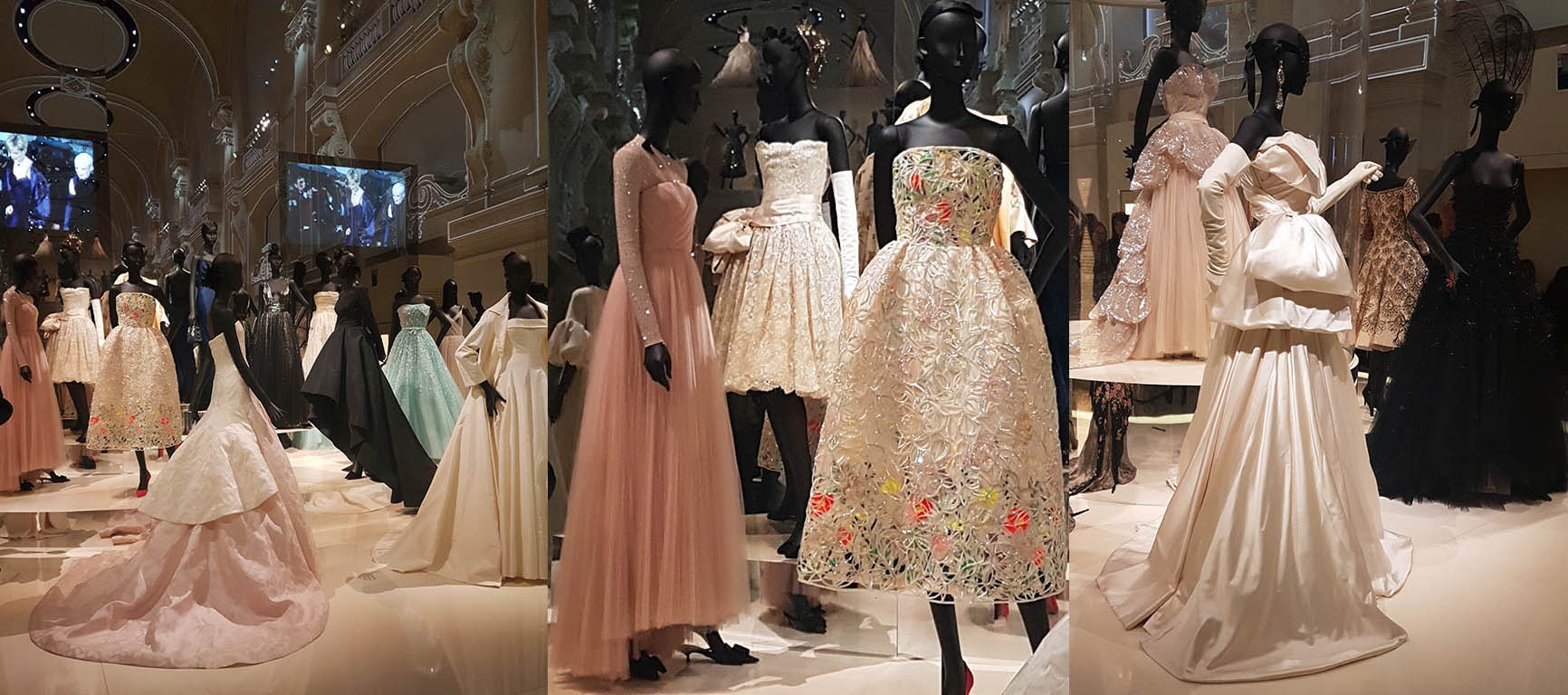
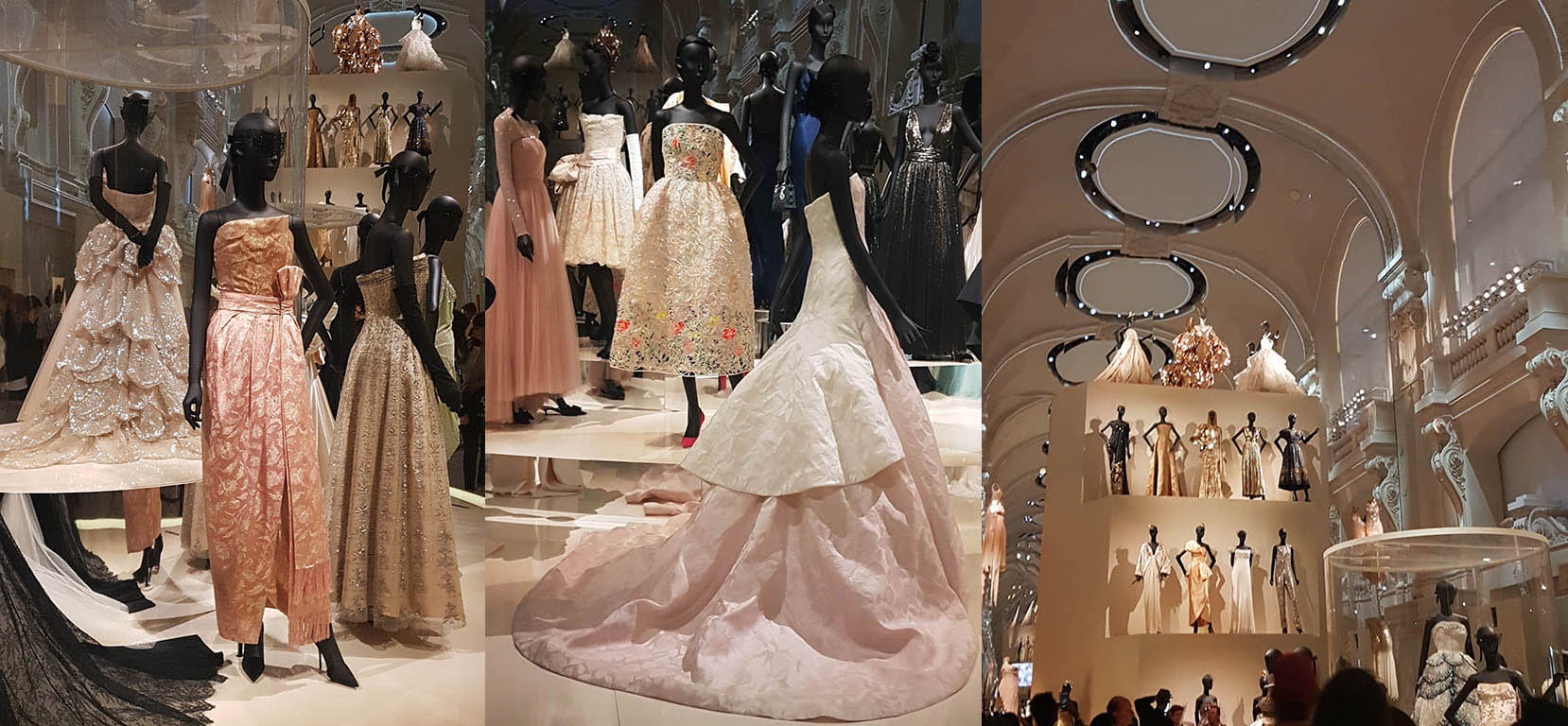
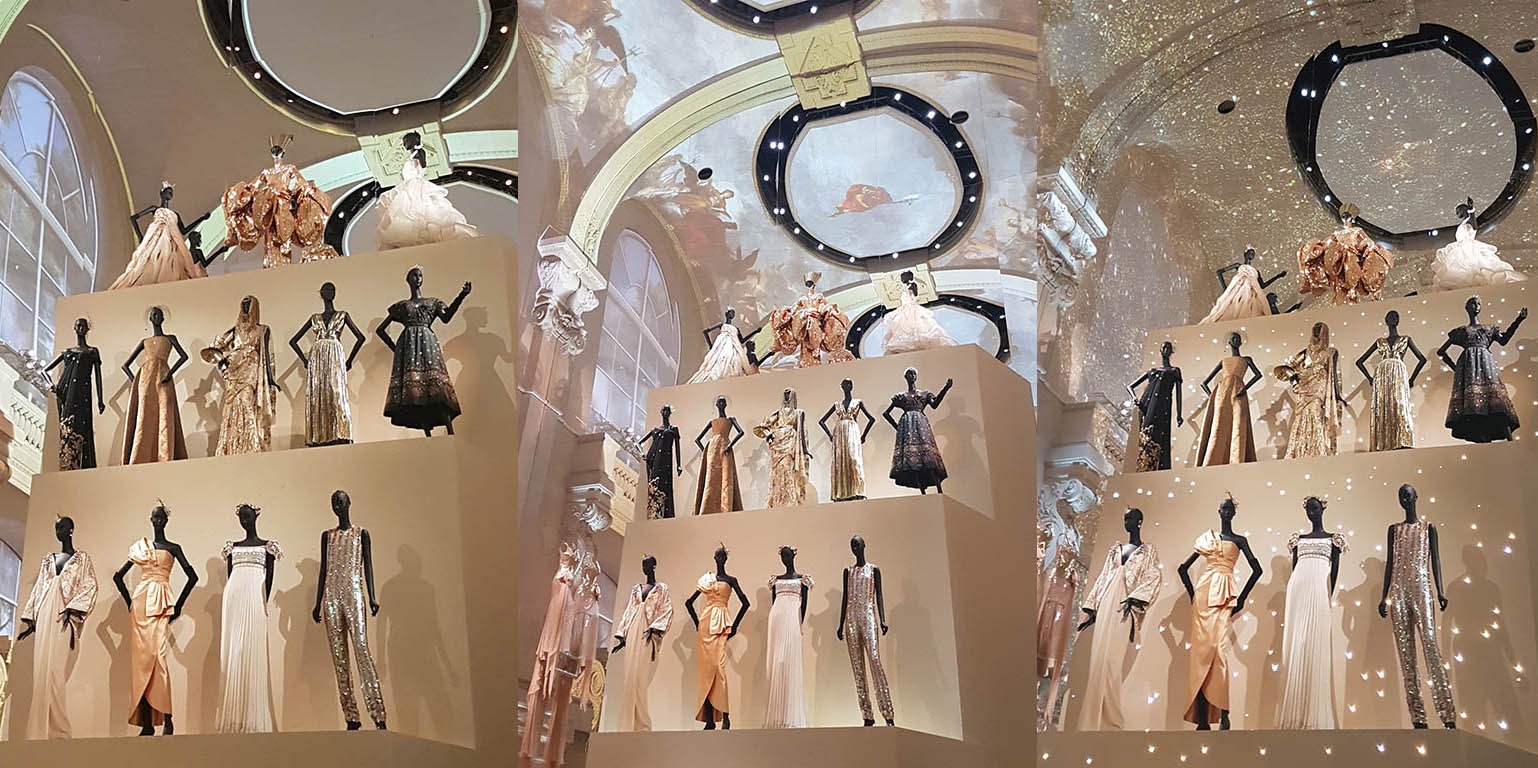
Music with a sound of sparkle and tingle built to a crescendo and then a moment of 'popping' as if a very soft bubble burst and Golden lights appeared across the platform and in the air around the audience. Like a scene from ancient mythology that the Old Masters had tried to illustrate a heavenly glow and aura shone down on the room like a thousand tiny fairies twinkling around the gowns. It held the gaze of all around and then day slipped into night and the heavenly goddess now created and deified in art where set amongst the stars of heaven.
Sun and moon, day and night. A feeling of eternity and an allegory I feel that fashion, more to the point style is a timeless language that travels across cultures and always finds it's way to someone who can understand. But coming back down to earth, it's a beautiful way to show how Haute Couture is enjoyed under the spotlights and amongst the stars. Dreams are made of this.
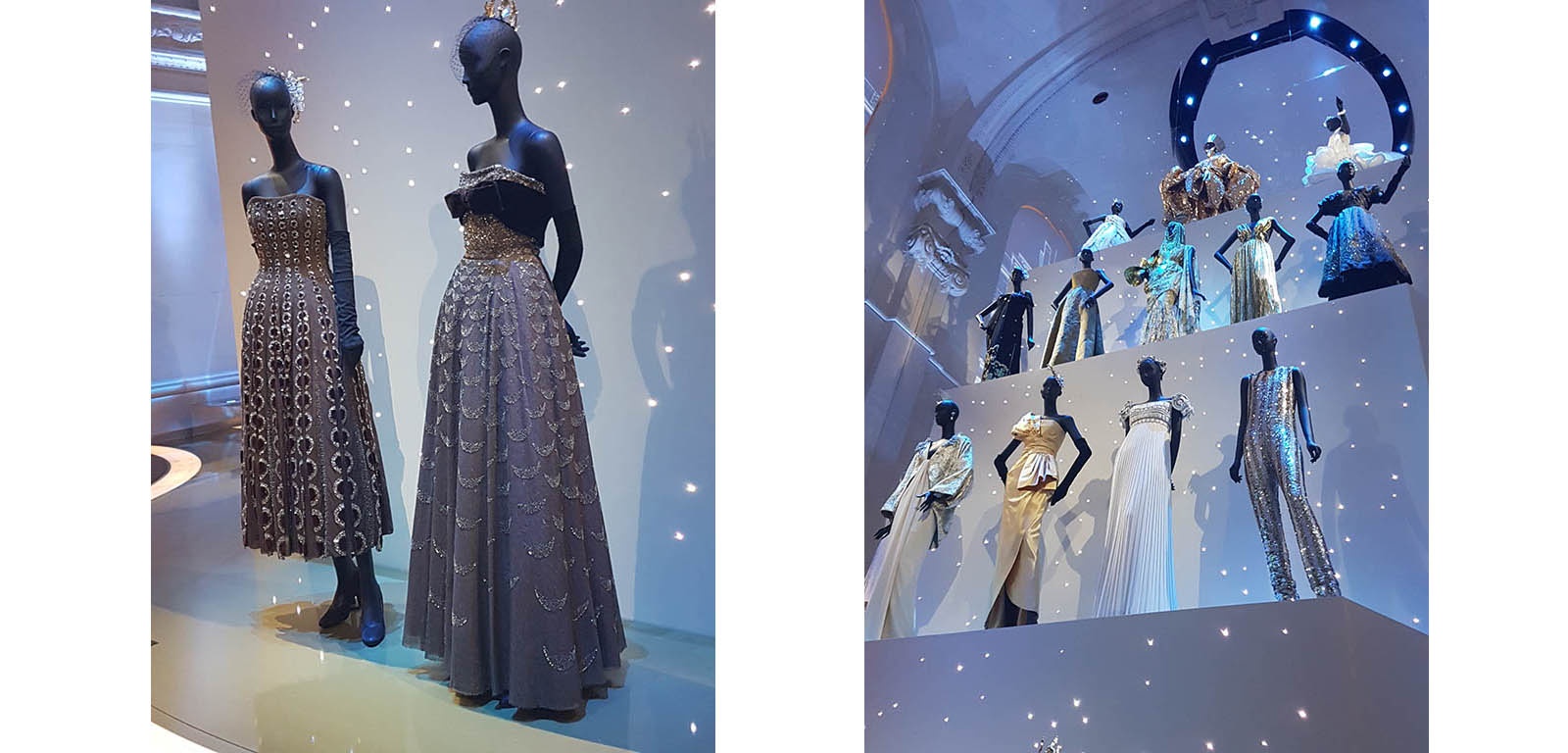
Above the entrance to the opening galleries of the exhibition a show reel of some of the most memorable looks from Dior.
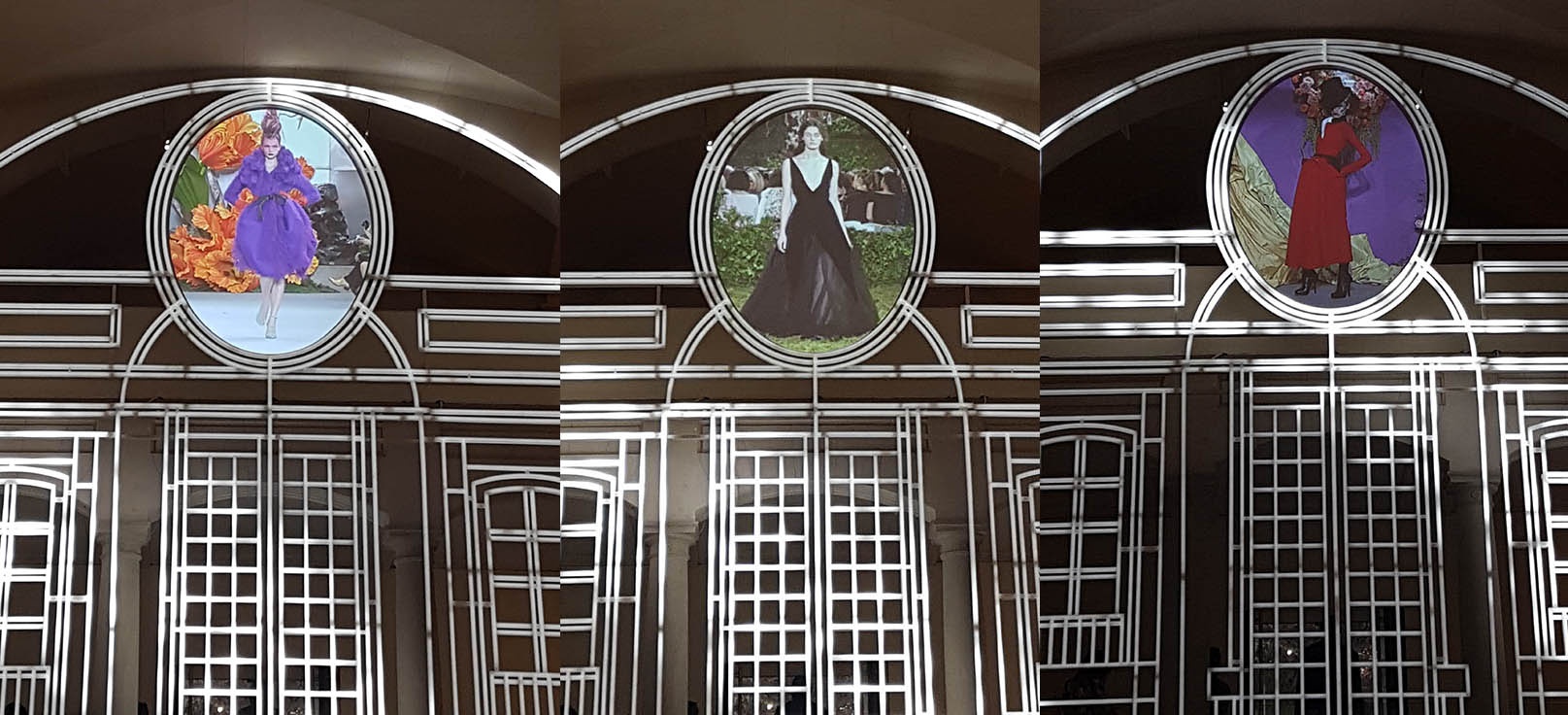
Dresses and faces of models familiar from our experience of the House popped up one by one and for anyone not well versed in Dior's history, perhaps for someone accompanying a fashionable friend it was easily digestible and a beautiful collection in itself to watch.
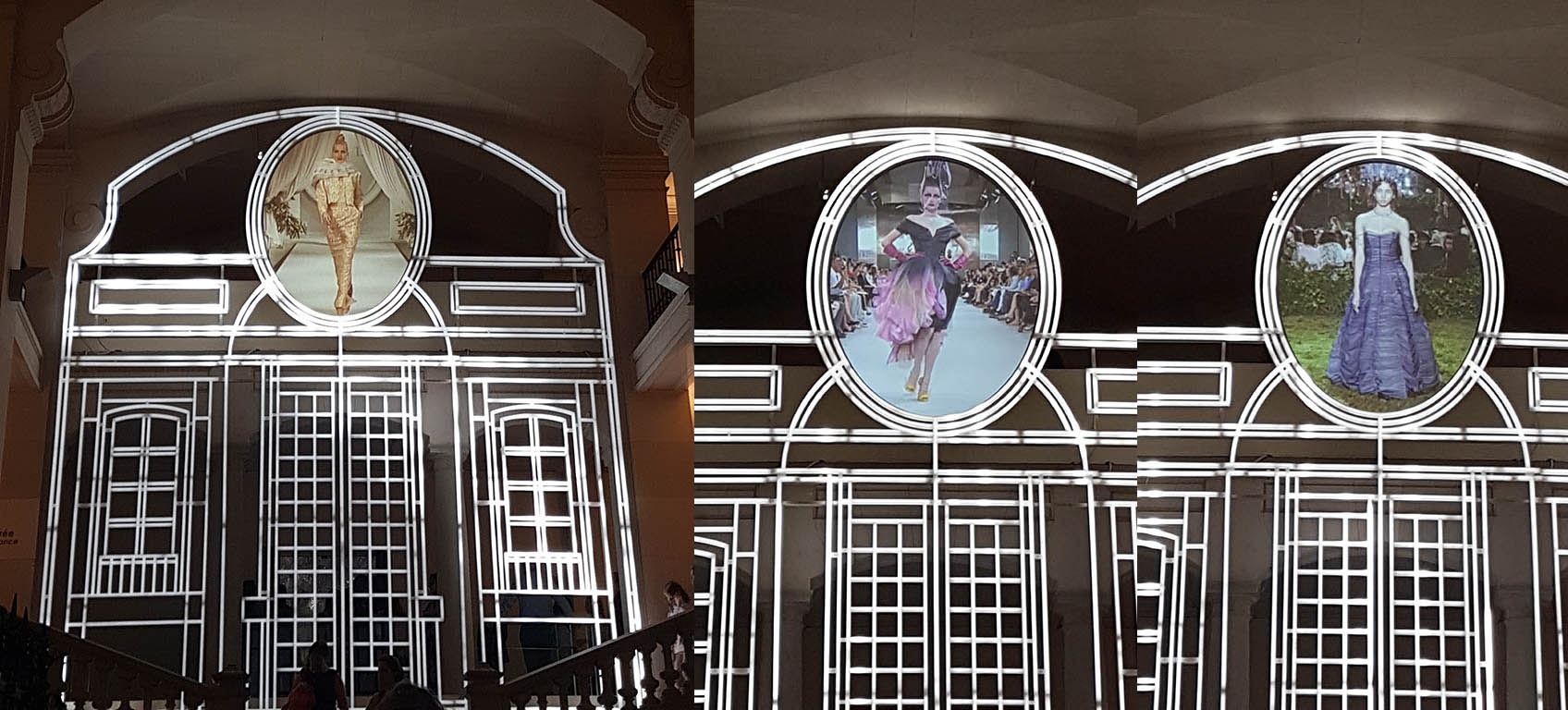
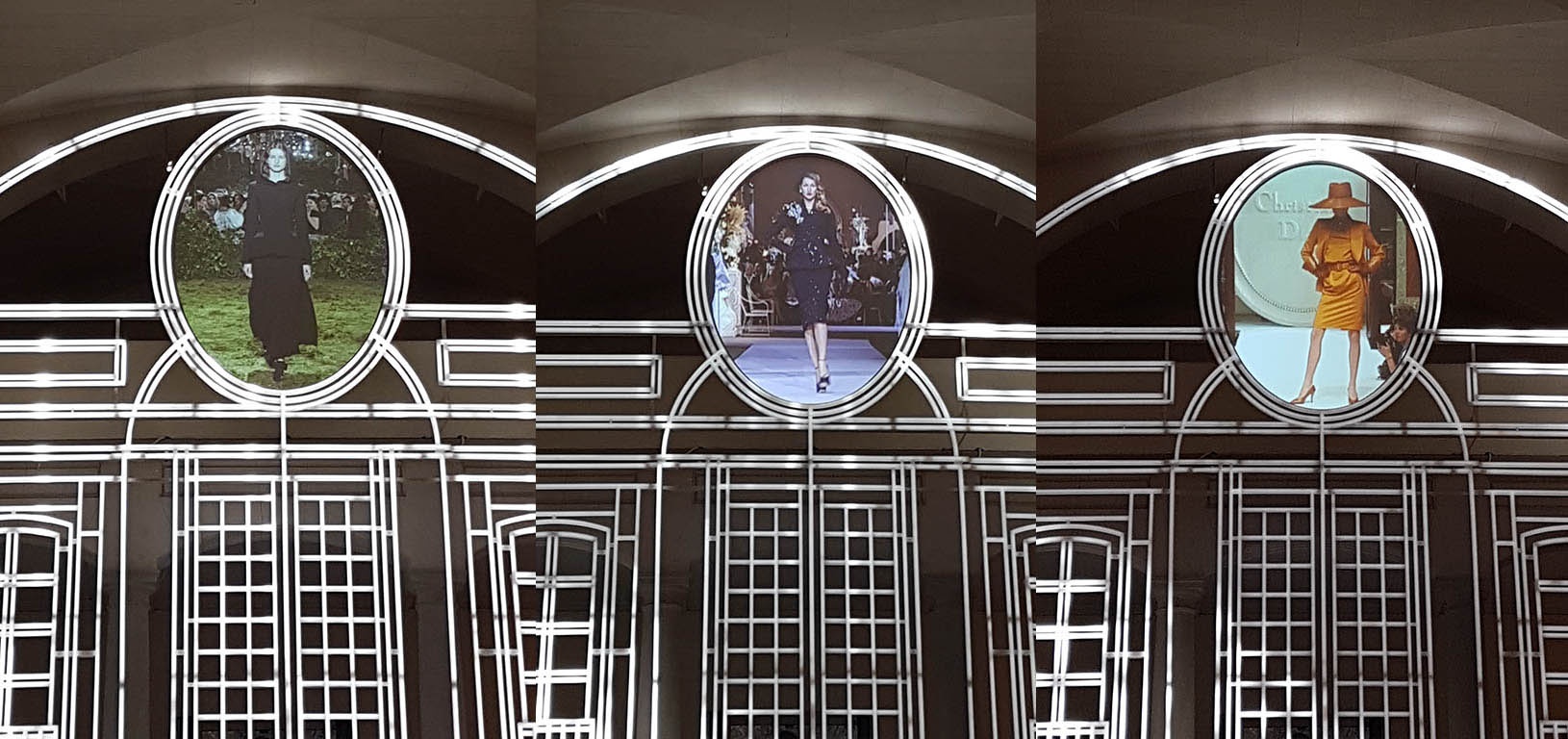
I think I must have snapped each dress as it came round through the real but clipped the collection down to the show some of the most dynamic looks and maybe the most well known.
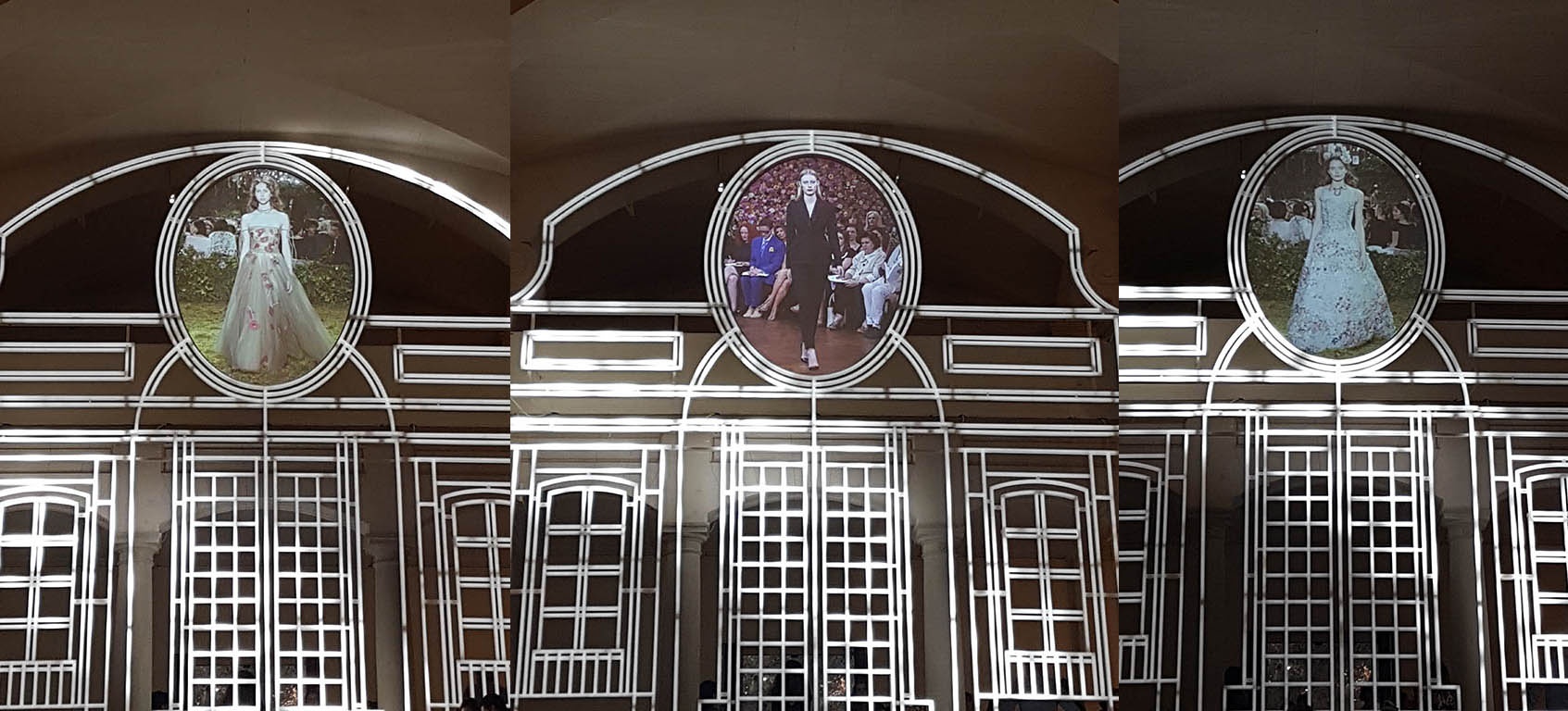
To finish with, my indulgence, I added a picture of my favourite dress. In the foreground of the picture with it's double layered Sugar Pink skirts and slim line bodice would be a perfect piece to wear by itself or with a jacket or wrap. Sweet dreams from Dior as always to put a smile on your face.
